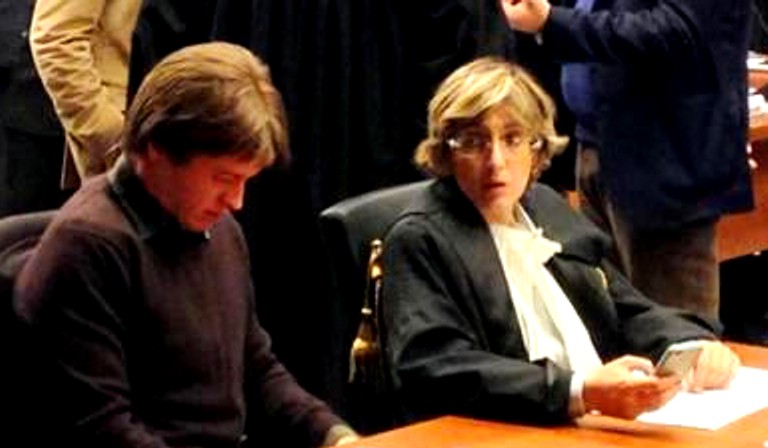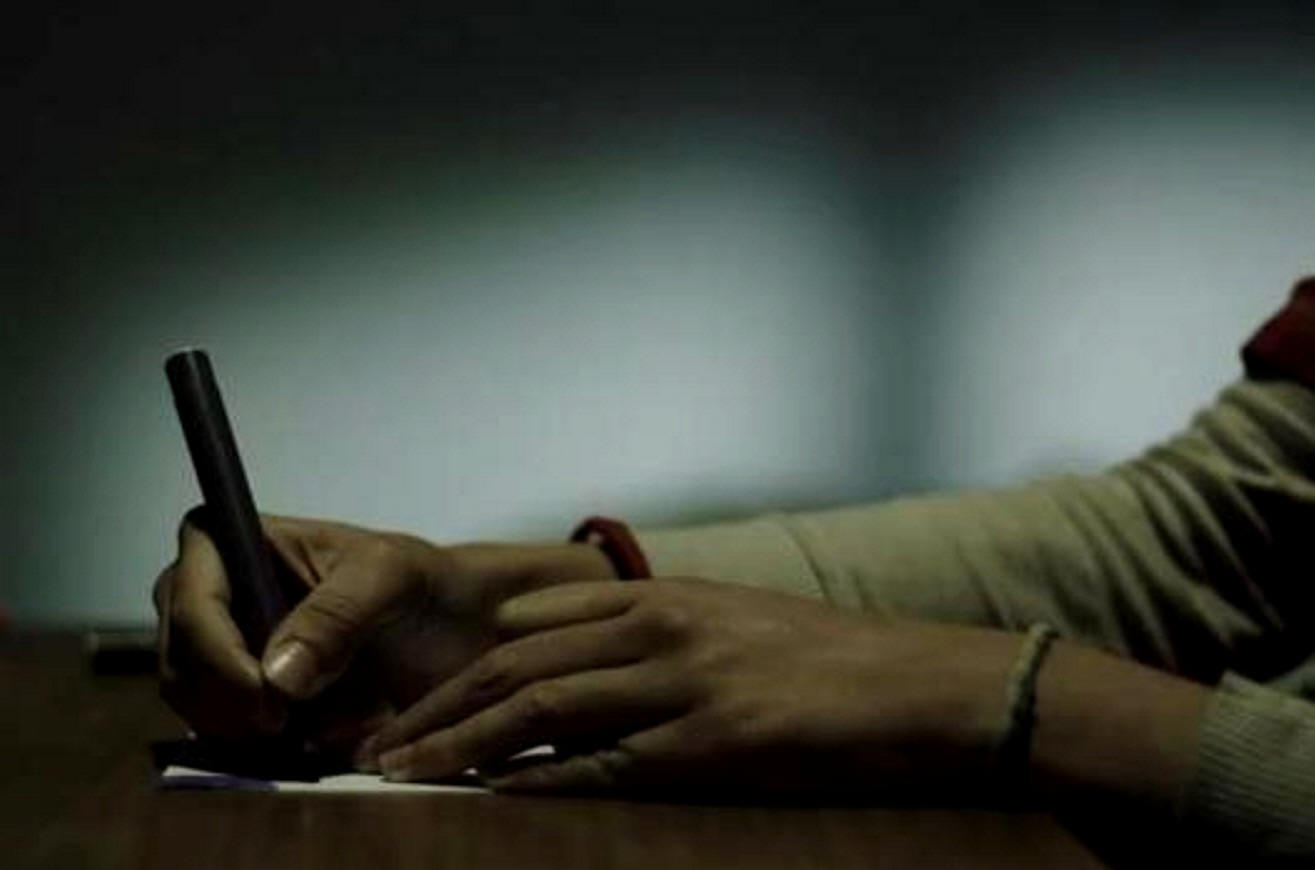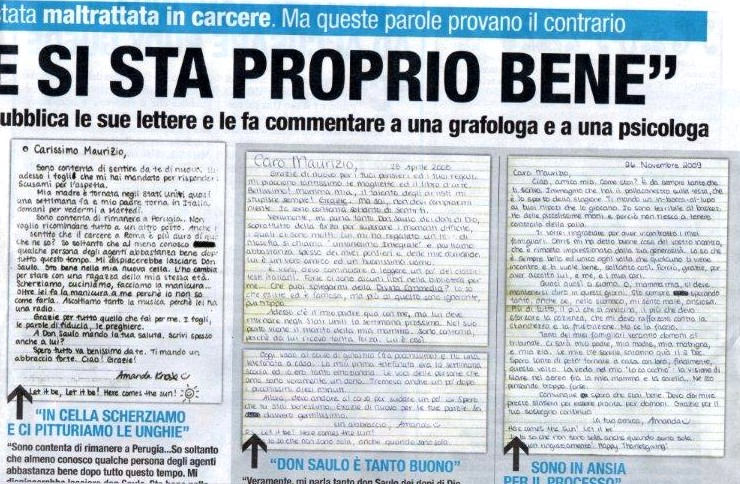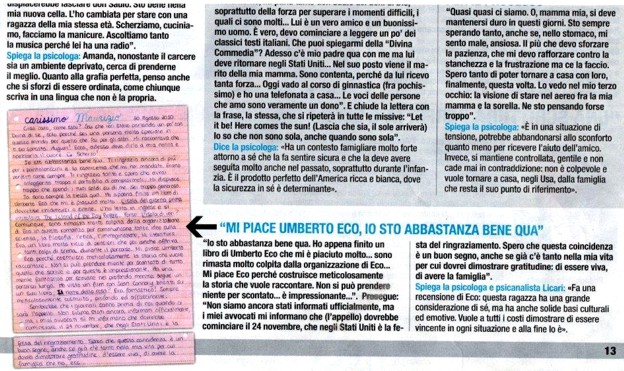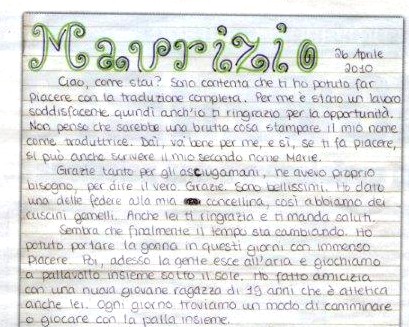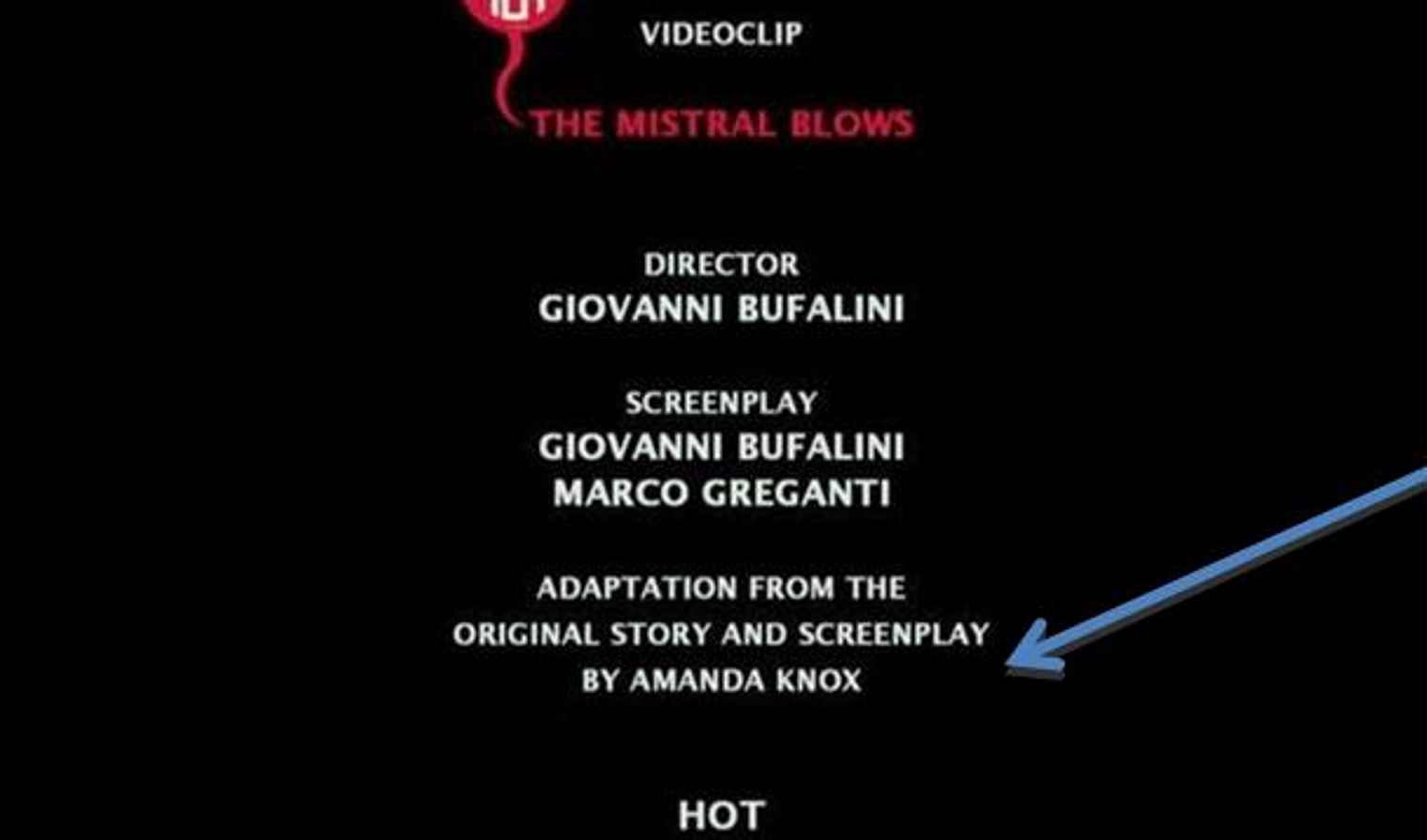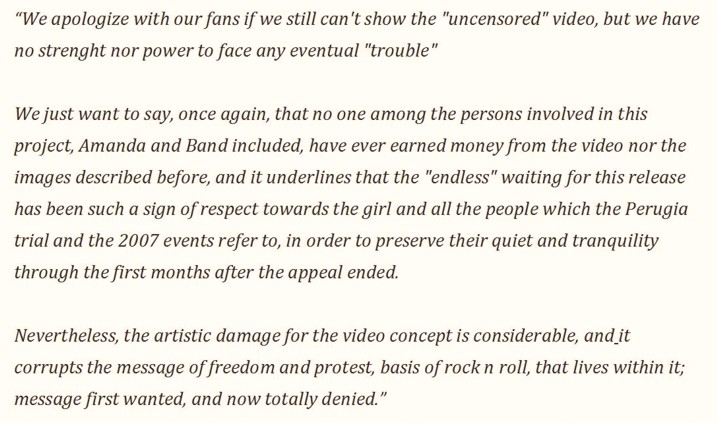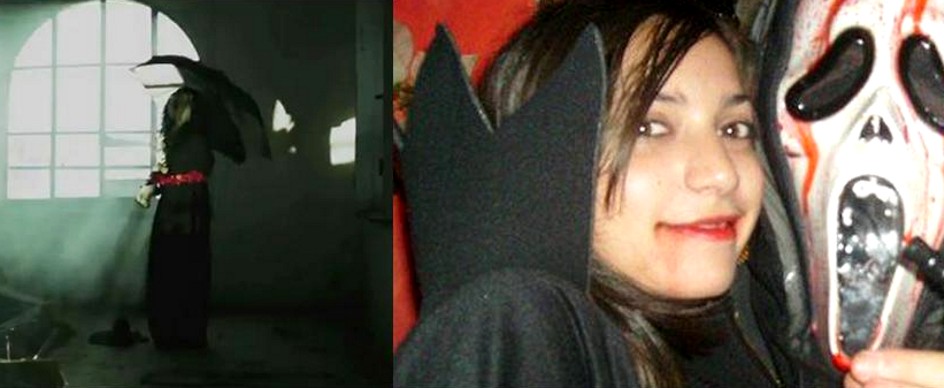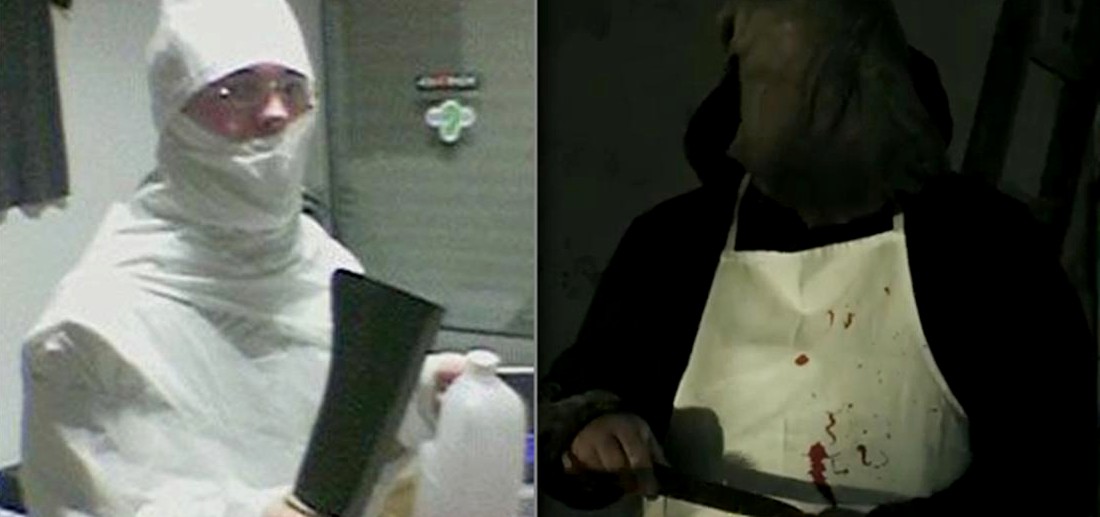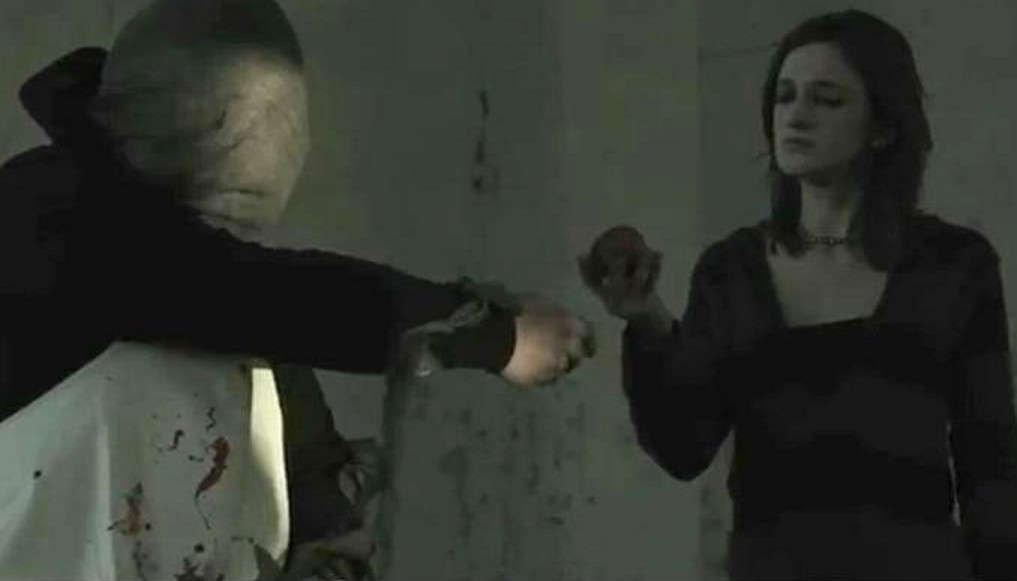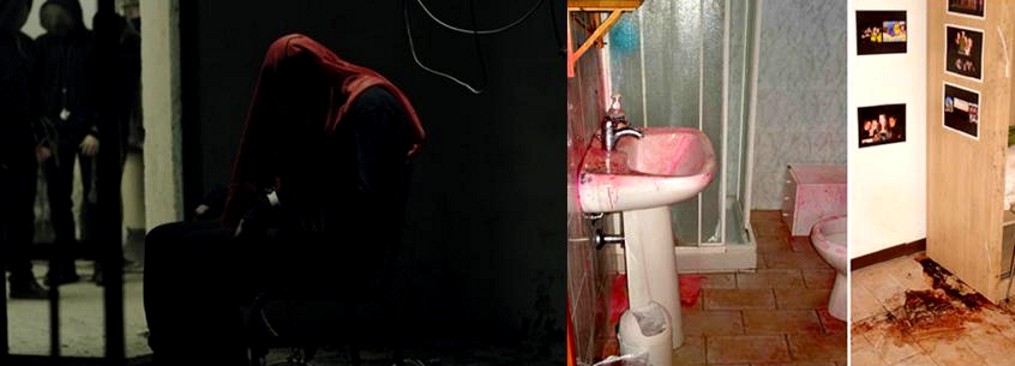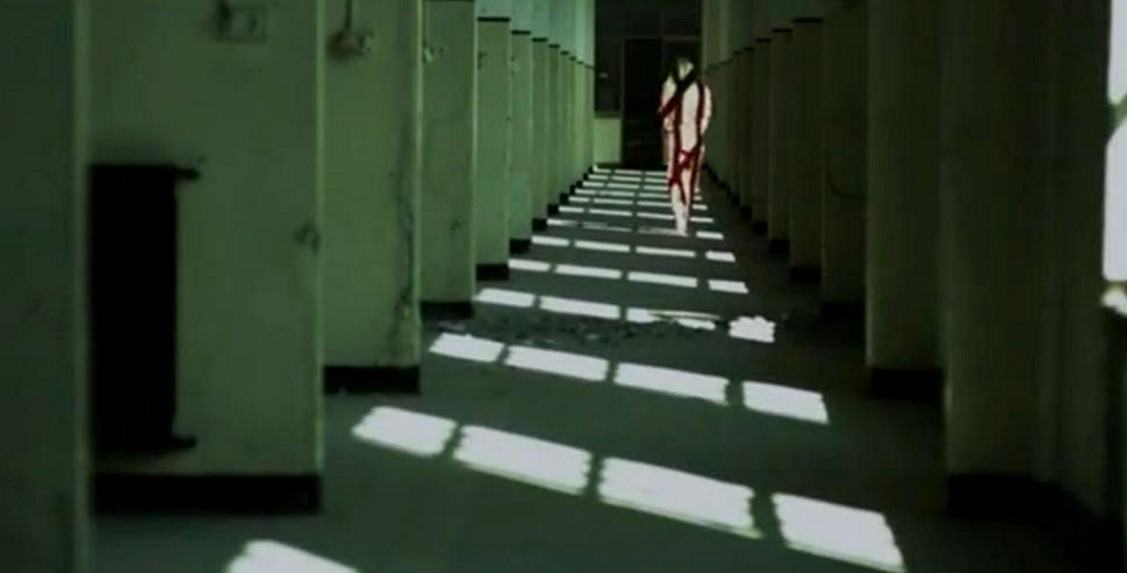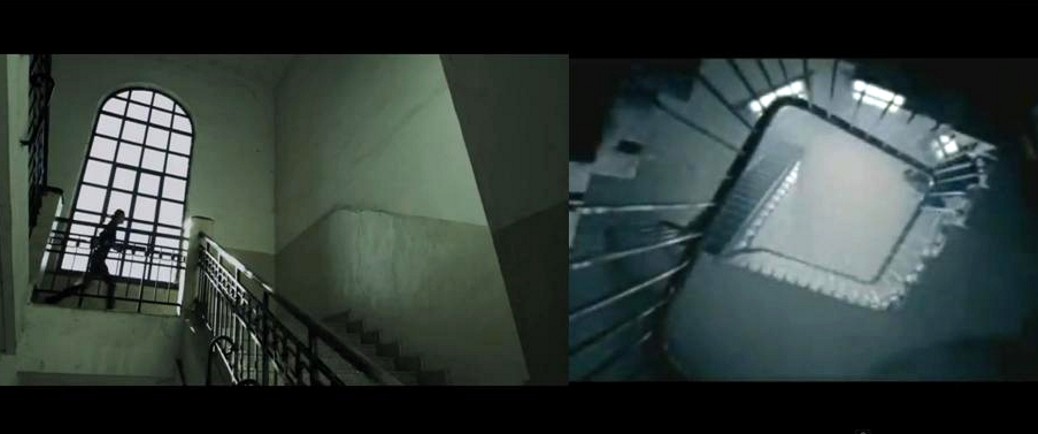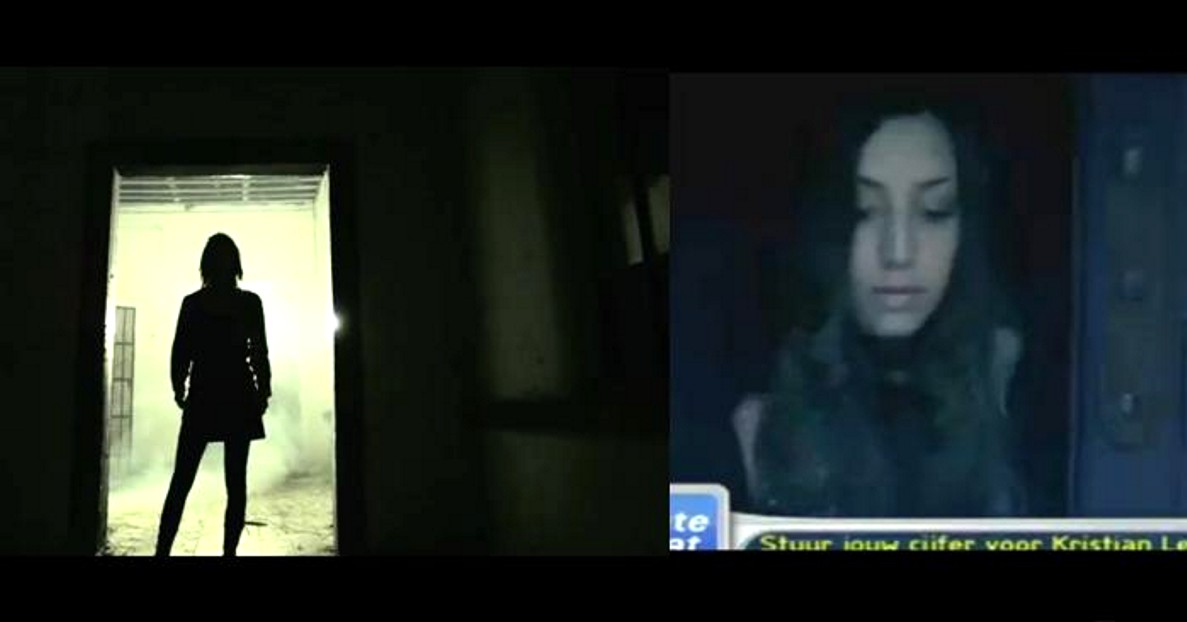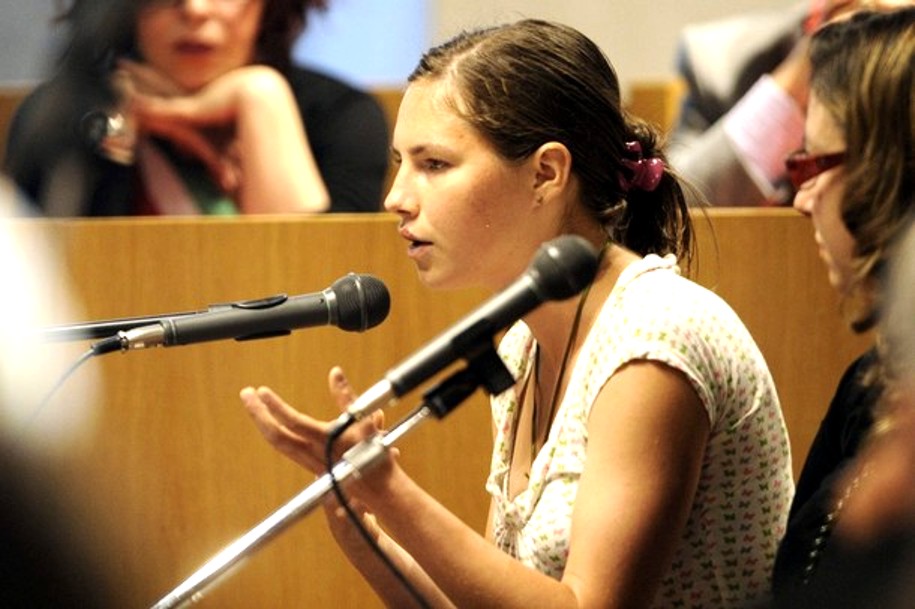
Category: The psychology
Monday, January 06, 2014
Curious Parallels Between Scott Peterson And Amanda “I Am Not A Psychopath” Knox
Posted by giustizia

[Above: Laci Peterson and Meredith Kercher, the victims in the two cruel crimes]
1. The Violent Deaths Of Laci Peterson and Meredith Kercher
Laci Peterson was soon to give birth in California in December of 2002. On Christmas Eve, her husband Scott reported her missing. In April of the following year, her body and the body of her unborn son Connor were discovered in the San Francisco Bay.
Five years later, in Italy, on 2 November 2007, foreign study student Amanda Knox was at her rental home with her Italian lover Raffaele Sollecito in Perugia, Italy, when the postal police arrived early one morning to return some cell phones traced to her flatmates; the phones had been found dumped in a nearby garden.
Shortly after, the shocking discovery was made that her flat mate Meredith Kercher had been murdered.
2. Parallels Between Knox and Peterson In Their Personalities, Crimes And Court Cases
There is a number of striking parallels between the behaviors of Amanda Knox and Scott Peterson and their alleged crimes and convictions.
The horrific murders of two beautiful young women (one almost at the end of the full-term pregnancy of her first child) unleashed in each case a maelstrom of publicity rarely seen in search of the murderer.
When arrests were made, there also came the stunning revelation in each case that the accused was well-known to the victim ““ in Laci’s case, it was her husband, Scott Peterson; in Meredith’s case, it was her roommate, Amanda Knox.
Ultimately, three people were arrested for the murder of Meredith (as we know, the fourth person arrested, Patrick Lumumba, falsely accused by Knox as Meredith’s murderer, was released when his solid alibi was proven). Of the three people arrested for the murder of Meredith Kercher, evidence suggested to prosecutors that Amanda Knox was the instigator of the crime.
In each trial, the defendant presented a seemingly normal and middle-class appearance. Neither defendant had a significant history of violence or widely-obvious mental illness. Their families insist on their innocence.
Yet both were convicted of brutal murders (and both now fight their convictions on appeal).
Knox and Peterson were each described by casual acquaintances, neighbors and friends as nice, regular people.
Ann Bird, Peterson’s half-sister, described him as being “charismatic, charming, courteous, polite.” On Dateline NBC television, a friend of Amanda Knox described her as being “generous, kind, genuine, optimistic, bubbly. Pretty much all the good words that you can find in a dictionary, she was.”
But they proved superficial assessments that in fact really only scratched the surface.
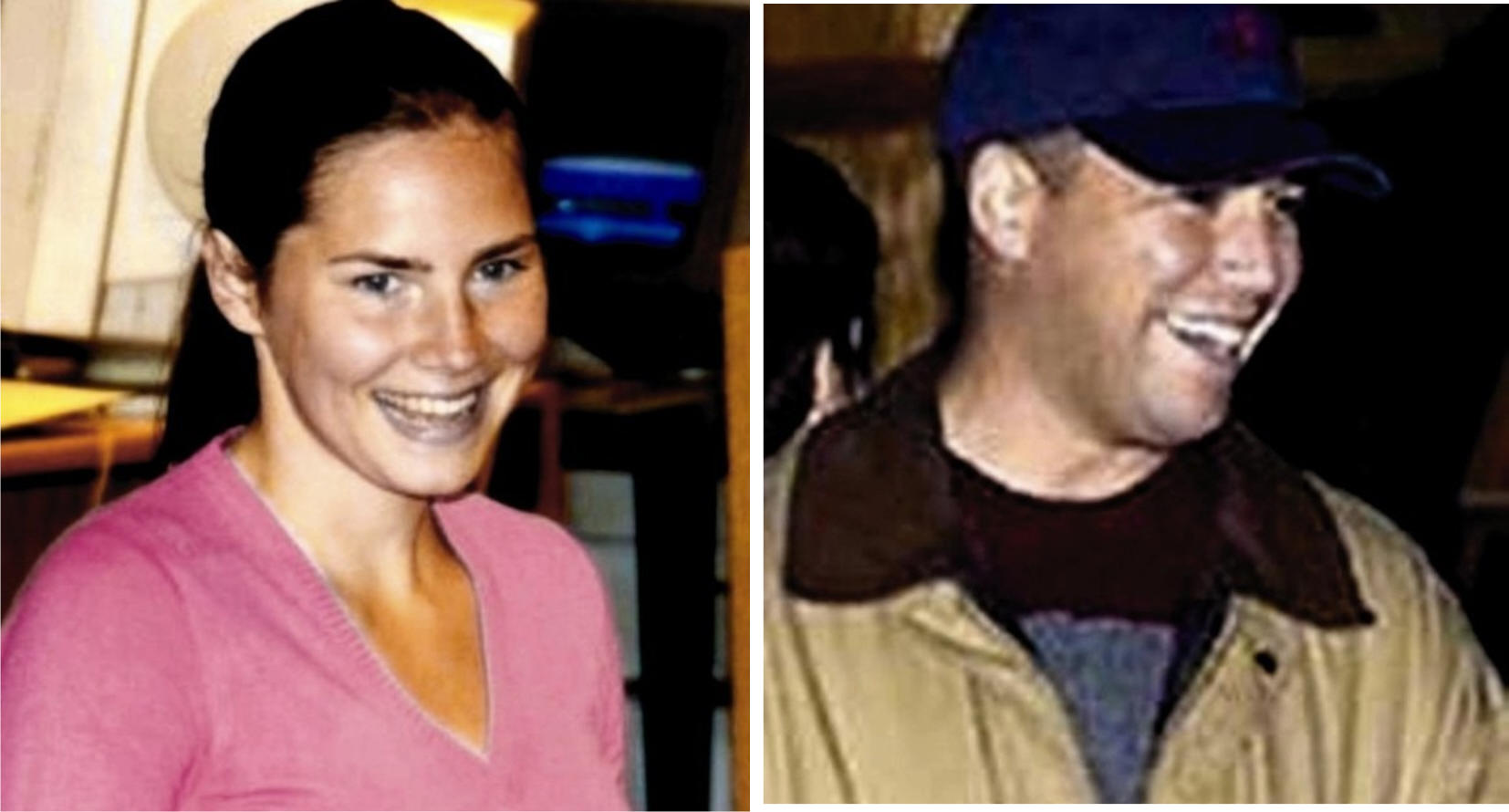
3. Reckless Odd Behavior And Lies By Amanda Knox
Amanda Knox had been cited and she had received a fine (a sentence which could have been more severe) for disturbing the peace and throwing rocks at a party in Seattle shortly before her departure to Italy.
Knox abruptly and without clear reason dropped a much-sought-after internship in Berlin, Germany, before arriving in Italy.
She posted a vignette on Facebook about a sexual liaison she had with a stranger, a middle-aged man, while on a train in Italy.
Her roommate Meredith had become increasingly disenchanted with the American flatmate who brought home different men without warning. “So she’s [Meredith] waking up in the morning and there’s someone making tea. And it’s, who are you again?” commented Meredith’s friend Brittany Murphy on the subject of Meredith’s unease at the strangers Knox brought to their rented Italian home.
Richard Owen, the Italy correspondent of the London Times in Italy, who has written multiple stories on the case, stated that Knox brought home “people who Meredith Kercher distrusted. Didn’t like the look of. It got to the point where she actually confronted Amanda about this.”
And Amanda Knox’s behavior after the Meredith’s murdered body was found in their rental home was more than atypical for someone who had their flatmate killed in such a horrific fashion in such close proximity.
- “As she put them on she swiveled her hips, pulled a face and said ‘hop la’ - I thought it was very unusual behavior and my suspicions against her were raised.” (Edgardo Giobbi, a police forensic scientist, testifying in court, describing Knox’s behavior just hours after the murder, after he handed Knox a pair of shoe-covers to prevent contaminating the evidence during a search of the house. Sky News, UK, May 30, 2009.)
- “While I was [at the police station] I found Amanda’s behavior very strange. She had no emotion while everyone else was upset. I remember one thing that really upset me. [Meredith’s friend] Natalie said, ‘I hope she wasn’t in too much pain.’ Amanda said, ‘What do you think? She fucking bled to death.’ At that point no one had told us how Meredith died.” (Robyn Butterworth, a friend of Kercher’s, testifying in court. London Evening Standard, Feb. 13, 2009.)
- “Their behavior at the police station seemed to me really inappropriate ... They sat opposite each other, Amanda put her feet up on Raffaele’s legs and made faces at him. Everyone cried except Amanda and Raffaele. I never saw them crying. They were kissing each other.” (Amy Frost, a friend of Meredith’s and a student at the University for Foreigners in Perugia at the time, testifying in court. The Independent, London, Feb. 14, 2009.)
- “My daughter was a Leeds student with Meredith in Perugia. They went out together on Halloween. When Amanda Knox was asked how she felt on 2 November, she said: “Shit happens”, which contrasts rather sharply with the contrived way she addressed the Italian court about “my friend Meredith”. (Marc Rivalland, in a letter to the editor of the Observer commenting on the Knox case. The Guardian, UK, 12/13/2009.)
- “They came into the shop at about 7 p.m. and were there for about 20 minutes. She bought a camisole and G-string. I heard her tell him that “˜Afterwards I’m going to take you home and put this on so we can have wild sex together.” (Store owner Carlo Maria Scotto di Rinaldi’s testimony in court about Knox and Sollecito’s behavior in his store, taped on closed-circuit TV.)
- “Knox and Sollecito were seen laughing as they hold up various G-strings. In one still shot taken from the footage, Raffaele is standing behind Amanda with his hands on her hips and his groin pressed into her. It was the same day as the candle light vigil memorial for Meredith, a few days after her murder.” (Excerpt from the book Angel Face by Barbie Nadeau.)
Perhaps the most controversial claim in the Knox trial was Knox’s accusation of Patrick Lumumba as the murderer of Meredith Kercher. Lumumba was placed under arrest and jailed for two weeks, until his solid alibi set him free.
Knox, who said nothing to help him during the two weeks Lumumba was incarcerated, changed her story after he was freed. She then claimed she was coerced by the police into making confusing statements. Knox’s entourage have made charges of human rights violations and anti-Americanism against the Italian justice system, though to date the U.S. government has refused to become involved.
- “He’s bad. He did it. He killed her”¦It was him, it was him, he was crazy, he killed her.” (Amanda Knox’s statements, according to police at the police station, accusing Patrick Lumumba of murdering Meredith Kercher. The Daily Telegraph, UK, March 6, March 21, 2009)
- “She was angry I was firing her and wanted revenge. By the end, she hated me. But I don’t even think she’s evil. To be evil you have to have a soul. Amanda doesn’t. She’s empty, dead inside. She’s the ultimate actress, able to switch her emotions on and off in an instant. I don’t believe a word she says. Everything that comes out of her mouth is a lie. But those lies have stained me forever.” (Patrick Lumumba, bar owner in Perugia and Knox’s boss. Daily Mail, UK, November 25, 2007)
4. Reckless Odd Behavior And Lies By Scott Petersen
Scott Peterson had all the appearances of an upwardly mobile middle-class white-collar worker. He was a salesman with a pretty wife and a baby on the way, and they owned a nice home in Modesto, California.
His friends and family described him as charismatic and friendly. But under the surface was a lifestyle filled with lies and mistresses.
Scott Peterson had hooked up with a mistress, Amber Frey, in November of 2002, leaving his pregnant wife home alone during the holiday season to see Amber Frey, with excuses of business meetings.
Peterson told Amber Frey that he was a widow, and also that he was traveling in France when he was actually in California - two of many false claims Peterson made to her.
- “I’m near the Eiffel Tower. The New Year’s celebration is unreal. The crowd is huge.” (Scott Peterson, from a taped telephone conversation to his mistress Amber Frey, telling her he is in Paris, when he is really in Modesto, California, about to attend a candle-light vigil for his missing wife. Dateline, NBC, 1/4/2005)
Shortly after Laci Peterson was reported missing, that candle light vigil was held for Laci. It was on New Year’s Eve.
- ”˜Three witnesses testified that Peterson’s behavior at the candle-light vigil seemed inappropriate for a worried husband. One woman said that he showed no emotion during the service and was grinning as he “socialized” with friends afterwards.’ (From The Murder of Laci Peterson, TrueTV.com)
The jurors were shown a photo of the grinning Peterson at the vigil at the trial as evidence. He called his mistress before and after the vigil ceremony, while Laci’s distraught family members tried to cope with the situation of their missing relative.
- “Scott came in with a great big smile on his face, laughing, it was just another day in paradise for Scott, another day that he had to go through the motions,” said one juror, Mike Belmessieri. “Scott had no emotion on his face. Scott was being Scott.” (Juror of the Scott Peterson Trial, commenting on his unusually cool demeanor in court. New York Times, March 17. 2005)
Shades of Amanda…
- “The cartwheels? This is Amanda just being Amanda. As her friends would say, it’s an Amanda thing.” (Edda Mellas, commenting on Knox turning cartwheels at the police station. The Guardian, UK, June 27. 2009)
- “I couldn’t help but think how cool and calm Amanda was. Meredith’s other friends were devastated and I was upset, but Amanda was as cool as anything and completely emotionless. Her eyes didn’t seem to show any sadness, and I remember wondering if she could have been involved.” (Giacomo Silenzi, Meredith’s Italian boyfriend who lived in the apartment downstairs from the murder. Metro.co.uk, November 18, 2007)
5. Parallels In Forensic Evidence
In both cases, there were no eye witnesses or “smoking gun.”
In Scott Peterson’s case, the ONLY piece of hard evidence was a single strand of Laci’s hair, found on pliers in Scott’s boat, which the defense charged as being contaminated evidence.
This and all rest of the evidence at his trial was circumstantial. Nobody witnessed any deed.
Both the circumstantial and forensic evidence in the Knox trial were more considerable. Key items of hard evidence included the knife found in Sollecito’s apartment that had Meredith’s DNA on the tip and Knox’s DNA on the handle, and it was accepted at trial as one of the murder weapons.
A bloody footprint, the size of Knox’s foot, was found on a pillow underneath Meredith’s body. Mixed DNA material of both Knox and Meredith were found in several spots in the house where the murder occurred.
6. Parallels In Strange Coincidences
Laci and Connor’s bodies were found in the water in the bay area of San Francisco. Scott Peterson happened to own a boat and liked to fish ““ in fact, he said he went fishing on Christmas Eve, the day Laci disappeared, at a location where later the bodies turned up only about 3 miles away.
Meredith was sexually molested, strangled, and ultimately killed by knife stabs. Raffaele Sollecito has a fascination with knives and he owns a large collection. Amanda Knox created and posted a fictitious story about a violent rape on the Internet.
Sollecito posted a photo of himself on the Internet swathed in bandages and holding a large meat cleaver and a jug of a chemical-looking liquid. Knox and Sollecito were the only ones at the house on the day when the police showed up and later discovered Meredith’s body.
The juries in both trials concluded that these factors were more than mere coincidences, and represented incriminating evidence of guilt of the crime.
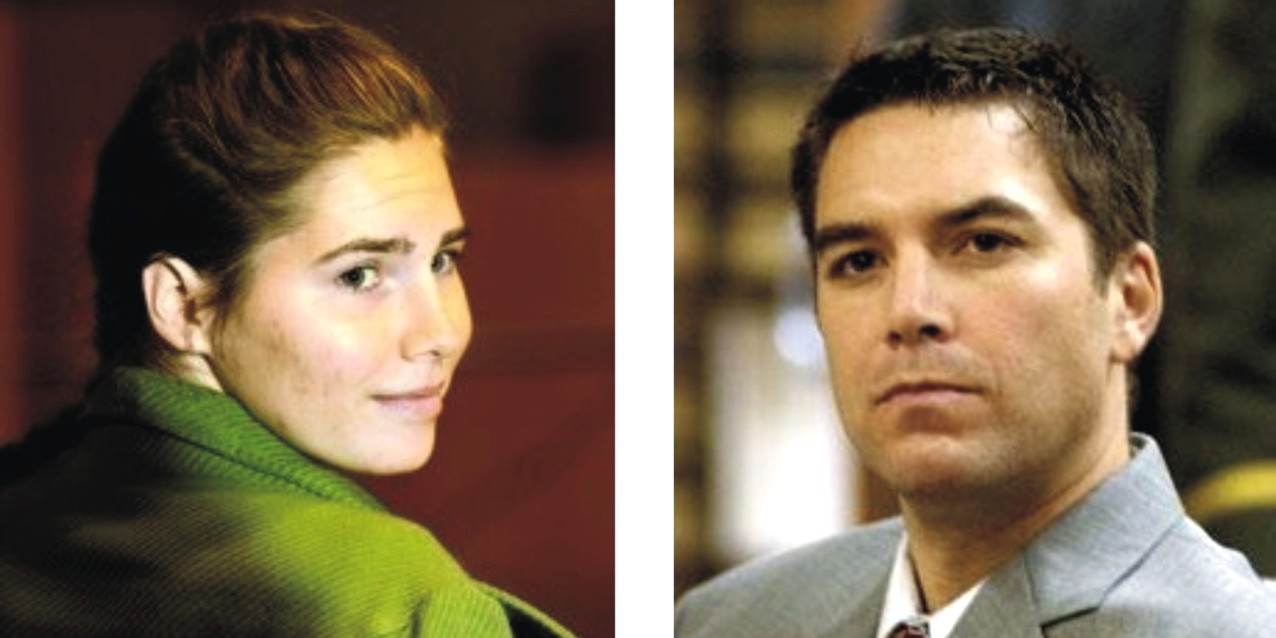
7. Parallels In How The Families Supported Their Children
Not all convicted murderers have a history of mental disturbance or violence. If there were any red flags regarding Knox’s and Peterson’s behavior, one would not know it from the descriptions provided by their families:
- ”˜Lee Peterson said his son never posed a discipline problem, did not rebel as a teenager and was a perfect baby. He was said even to lose golf games because he did not want to hurt the feelings of his opponents. ‘‘He woke up smiling and went to bed smiling.’’ (Scott Peterson’s father of his son, testifying to the jury after Scott’s guilty verdict but before sentencing. New York Times, December 2, 2004)
- “She was an incredible easy-going kid even from a baby. She was so mellow”¦She loved being read-to, she loved books. As she got a little older she always wanted to be outside - building camps, playing soccer. She never watched a lot of TV - she still doesn’t. She was an excellent student.” (Edda Mellas, commenting on Amanda Knox’s character the week of her guilty verdict. The Sun, UK, December 5, 2009)
8. Parallels In Family And Groupie Websites
Peterson and Knox’s families insist on their innocence. There are family and groupie websites for each convicted murderer. They each proclaim innocence for the guilty, make charges of police incompetence, and make requests for money for the defense cause and legal expenses:
- “Scott Peterson Family Mission Statement: “˜This web-site is a combined effort of our family and our support system. We know Scott is innocent and that he has been unjustly convicted. Our pursuit of justice for Laci, Conner and Scott remains steadfast. We want to keep you informed as to the specifics of the case, the appeal, and related topics. We also want you to know how grateful we are for your prayers and support.’ (From: http://scottpetersonappeal.org/)
- “Amanda Knox - A heartfelt thanks for your support. On behalf of Amanda and her family, we want to thank everyone who has contacted FOA to express their concern and to offer help in the wake of an unjust and unsupportable guilty verdict. We are developing a strategy to raise public awareness of this case and help bring about a reversal of the verdicts against both Amanda and Raffaele. Once it is in place, we will welcome all the help we can get, and we will be in touch with you.” (From http://www.friendsofamanda.org/home_eng.htmleartfelt)
Scott Peterson of course has never managed to get online. Amanda Knox of course runs a jubilant, taunting blog which trashes the memory of the victim and harasses her family - a first in global crime history and a foolish move given the current cold, remorseless rejection of her appeal.. Knox’s blog has a following among others also seemingly unable to succeed in normal ways.
9. Parallels In The Verdicts Jurors Delivered: Guilty As Charged
The jurors in each trial fitted together all the pieces of the puzzle: timelines, witness testimony, cell-phone records, forensic evidence, lack of solid alibis, incriminating lies, and odd behavior of the defendants.
They each concluded after lengthy deliberation that the defendants were guilty of murder.
10. And The NON-Parallels In How The US Media Has Reported Both Cases
Of these two cases, not many people have questioned the jury’s decision in the Scott Peterson trial. He has been sentenced to death via lethal injection, and he is currently incarcerated in San Quentin prison in California.
There are no repeated media interviews of Peterson’s mother in tears, insisting on his innocence and his release from prison. There are no angry declarations from Peterson family that the police, prosecution and legal system abused, railroaded and framed Scott Peterson.
If such media coverage were to exist, it would be widely considered in the US to be extremely upsetting and insulting to Laci’s parents and family and to the memory of the victims Laci and Connor.
Peterson’s media coverage, thankfully, has dissipated. He still pursues an appeals process, possibly to be heard next year by the California Supreme Court.
Amanda Knox’s story plays out very differently. After her arrest, her family hired a public relations team that puts forth a determined effort to change Knox’s image of wild child and murderer and to keep her in the news.
They obviously do not consider their repeated loud public outcries for release of their daughter distressing to Meredith’s parents and family, and they don’t perceive their actions as being disrespectful to the victim, Meredith.
Or of course, as many people suspect, perhaps Knox’s relatives do realize it but they simply don’t care.
11. Parallels In Future Legal Prospects
Imprisoned in Italy, Knox has been sentenced to 26 years in prison. She is now appealing that verdict and sentence for the second time after the first appeal was corrupted. In 2012 Scott Petersen’s lawyers filed the automatic appeal against his death sentence to which he is entitled by California law. He may end up serving life.
Knox’s prospects seemed considerably brighter than Peterson’s when the now-annulled Hellmann appeal of 2011 set her free. Now under the worst scenario she loses her new appeal and may end up serving life.
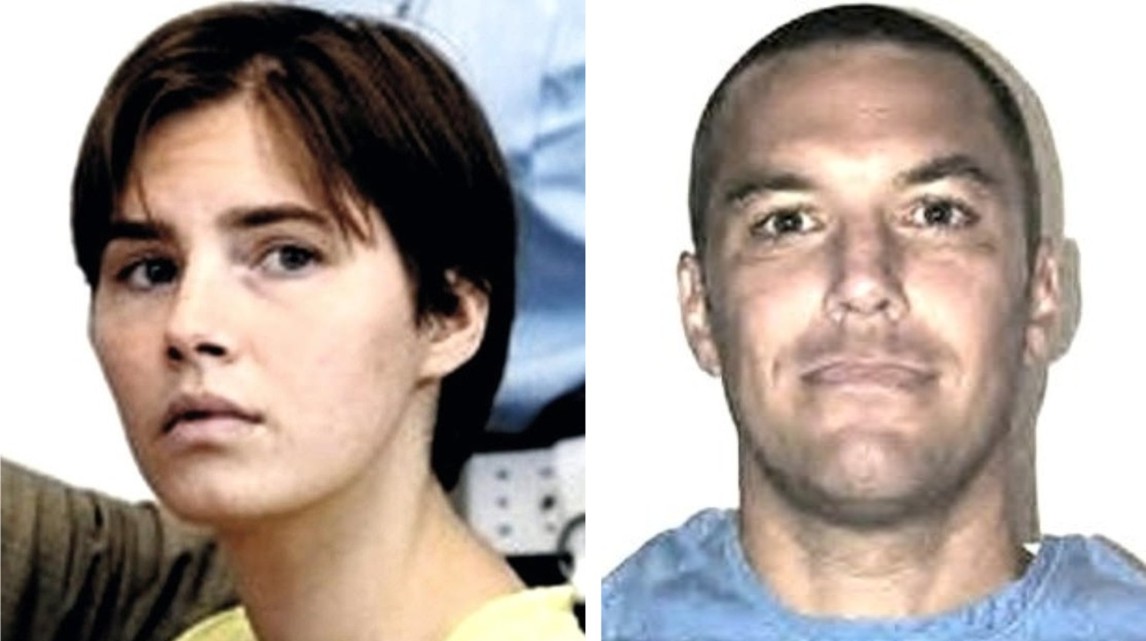
12. Epilogue ““ Master Manipulators
It is curious that the fervent supporters of Amanda Knox do not crusade for the release of Scott Peterson as well. After all, he was convicted on LESS direct evidence, and also in the midst of a maelstrom of publicity. CNN.com had called the Peterson prosecution case so weak and “unimpressive” that they speculated that he could end up with a “Not Guilty” verdict.
But with the exception of his own family, no one has picked up beating the drum to overturn the jury’s conviction of Peterson. Perhaps it is because Peterson doesn’t fit well the damsel in distress role? More likely, it is because the American public trusted the jury’s assessment of the evidence and trial, as they and the American media usually do, and they feel that the jury delivered a just verdict, and justice to Laci and Connor Peterson.
How is it possible that two “regular” people like Knox and Peterson ended up in jail for horrendous murders? Below is a condensed version from an AP article about the type of personality attributed to Scott Peterson:
It is interesting to note that life transitions are tremendous stresses to a psychopath. Psychopaths also wear “false faces” and are master manipulators. They are the ultimate con artists and they are able to fool even those closest to them.
Peterson’s closest friends “never suspected there was a monster inside Scott’s psyche.
Motive still a question in Peterson case
By the Associated Press
Tuesday, December 21, 2004
REDWOOD CITY, Calif. (AP)””Of all the questions surrounding the Laci Peterson murder case, the one that seemed to be running through practically everyone’s mind was this: If Scott Peterson was so unhappy in his marriage, why didn’t he just get a divorce?Experts on the criminal mind say the answer may lie in what lurked beneath Scott Peterson’s charming veneer “”a psychopathic personality.
“When you say you’re going to get a divorce, everyone knows that it’s a long, tedious process. The psychopath wants the short-term solution,” said San Diego forensic psychologist Reid Meloy.
Peterson, 32, was convicted earlier this month of murdering his eight-months-pregnant wife and the fetus she was carrying, and the jury decided he deserves the death penalty.
Criminal psychologists say Peterson appeared to be a master manipulator who lacked the capacity to feel remorse or consider consequences “”some of the same psychopathic characteristics exhibited by serial killers Ted Bundy and John Wayne Gacy.
Psychopaths “tend to con people very well and they wear false faces,” said former FBI profiler Robert Ressler. “They tend to be able to fool everyone from their families to their friends to society, schools, their community.”
At Peterson’s trial, prosecutors portrayed him as a callous liar who continued to carry on an extramarital affair even as police searched for his wife. They said he killed her to escape marriage and impending fatherhood for the freewheeling single life.
Whether Laci’s pregnancy was the catalyst for Peterson’s plan may never be known. But experts said pregnancy can lead to seismic changes within a relationship.
Pregnancy “represents commitment, fatherhood, another dependent, a lifelong bond ... and all of those things are strongly despised by the psychopath,” Meloy said”¦ pregnancy represents a life transition, and there are stresses around that transition.”
Peterson’s case was made all the more perplexing by the lack of signs that the couple’s marriage was in trouble. Although Peterson had cheated on Laci at least three times, according to defense attorney Mark Geragos, he appeared to family and friends to be a doting husband and father-to-be after Laci became pregnant.
Those closest to the couple said they never suspected there was a monster inside.
Heather Richardson, the maid of honor at the Petersons’ wedding, is still hoping for a plausible explanation to emerge. Perhaps, she said, Peterson suffers from a disorder that has yet to be revealed.
“It would be at least comforting. Then I would realize that the person I knew and loved dearly was there. He was that person and the other person, too,” Richardson said. “So at least part of him was not a lie.”
Here is Amanda Knox in her own words talking about masks “” while taking the stand for the final time at her trial in Italy (CNN, Dec. 3, 2009): “They say that I am calm. I am not calm ... I fear to lose myself, to have the mask of the assassin forced upon me.”
This is an update of my post of 24 July 2010
Thursday, December 05, 2013
With Sollecito’s First Plea For Mitigation Seen As A Flop, His Behavior Seems Extremely Suspect
Posted by Peter Quennell

Sollecito headed for Dominican Republic, but stopped pending court okay
1. Post Overview
A week ago Prosecutor Crini had begun a two-day summary of the state’s case so stark and implacable that it had two effects on Sollecito.
He stayed in his hotel on the second day; and he then took off like a rabbit for some destination initially unknown and repeatedly lied-about by his father (see Part 3 below).
One of his lawyers (accidentally?) broke the secret. Sollecito had flown to the Dominican Republic. Where he just happens to have some really unsavory relatives.
2. High Drama In The Nencini Court
Sollecito has not ever taken the witness stand.
And given the minefield his foolish book and media claims amount to, don’t hold your breath expecting otherwise soon. However, last month Sollecito did use the Italian accuseds’ privilege of making an impromptu plea to the judges.
He was not under oath and not subject to cross-examination by the prosecutors. He did not address the copious evidence, and was seen as attempting to humanize himself to perhaps get some years knocked off a final sentence.
As always, Knox forces were left confused, thinking he had somehow helped both of them. But Sollecito repeatedly drew attention to his being an Italian and in effect to Knox and Guede not being Italians, thus once again separating himself from Knox on lines Barbie Nadeau also described here..
Our main poster Yummi was in the court and reported in part as follows:
One of the woman judges kept staring elsewhere and almost never watched Sollecito all the time he was talking. Sollecito’s speech itself was actually not that exciting. It was so overt that he was focused on portraying himself as a person who is so good and cannot hurt anyone, not the bad guy described in the media. The real and only topic of Sollecito’s statement was himself, who he is, his “true” personality, he begged them to look at what a good and suffering a boy he is…
And believe me, Sollecito was just whiny. For a big part of his speech he was just putting distance between who he is today and the person he was when he was 20 years old. He talked about the impossibility of finding a job (the job he would like to have in a corporation, obviously, not just any job) and wanted the judge to project to his condition from that of young Italians who can’t hope to see a future.
Then 10 days ago the skilled senior prosecutor Dr Alessandro Crini fired back, and effectively demolished Sollecito’s premature statement. As we reported, Dr Crini took nearly two days to do that.
Sollecito was again in court on the first day, but was seemingly unable to face Dr Crini’s onslaught on the second day. He remained holed up at his hotel.
Although Dr Crini settled on a lowest-common-denominator motive - a Lord of the Flies flare-up which had escalated into mob violence and the fatal stab to Meredith - his recounting of the evidence and associated behavior of the pack was comprehensive and very hard. Translated from Cronaca:
Meredith was treated “as if she was an animal.” In this way Dr Crini defined the dynamics of the murder of Meredith Kercher during his indictment.
According to Dr Crini, the attack escalated to the point where the attackers felt they “needed to get rid of a girl they had abused”. While Rudy Guede sexually abused Meredith Kercher, supine on the floor of her room, Raffaele Sollecito and Amanda Knox, according to the reconstruction, were at each side of the body of the victim.
“The mouth and neck of the victim were contained in a fierce way to avoid Meredith going berserk and screaming, and when Meredith did in fact manage to scream, she received the final fierce stab to the throat.” Two knives were used in the crime at the house in Via della Pergola on the night between 1 and 2 November 2007”...
Dr Crini referring to the bra clasp of the victim, said that “the presence of the DNA of Raffaele Sollecito is quite certain” and explained at length why there was no “possibility of contamination”.
Amanda Knox was at the scene of the crime, according to the identification made “‹”‹by the scientific police in Meredith’s room of an imprint of a shoe (female size 36-38 according to the results of the analysis)... On the pillowcase, the center of gravity of this bloody history, were found a palmprint of Rudy Guede and this print of the shoe.”
3. High Drama Right After End Of Court
Dr Francesco Sollecito was reported as being shocked by the unrelenting tone of the indictment. However, Sollecito’s plight is not nearly as bad as the ever-stubborn Amanda Knox’s.
Knox has already served three years and was fined heavily for obstruction of justice. She could face another year for that if it is found to have been aggravating. And as the post below mentions, she could face as many as three more charges for aggravating obstruction of justice.
Sollecito in contrast has respected the court by actually showing up, and, unlike Knox, has lately shown restraint in accusing his accusers.
However, the day after Dr Crini ‘s startlingly powerful summary of the case against him, it looked like Sollecito was hastily taking off out of Italy for somewhere.
La Nazione reported that police at Florence Airport had held back a fully loaded Air France flight to Paris while they checked with the prosecution that he was indeed allowed to leave the country. La Nazione said the prosecutors have some concern that he might skip and not come back, but he did voluntarily come back previously from the Dominican Republic, and his family has always ensured some presence in court.
But next TGCom24 reported that Sollecito’s father had claimed that Sollecito had already gone home to Bisceglie, although he is a free citizen still in possession of a passport and can travel anywhere if he wishes.
But then TGCom24 reported that he had indeed flown to Paris, but had turned around and come straight back again, to stay with family friends. And that on 8 December he will sit his final exams in computer science at the University of Verona.
However, soon after that La Nazione reported that Sollecito’s father had been contradicted by his lawyers, and his erratic son had slipped through his fingers and flown “for his work” back to the Dominican Republic. Translation by Jools:
1 December 2013 ““ SCOOP. Denials, lies, game by the defenders. But in the end it’s up to the lawyer Luca Maori to admit: “Raffaele Sollecito returned to Santo Domingo, as anticipated on Friday by La Nazione”
He embarked from Florence’s Peretola Airport and made a stop-over in Paris, from where he then flew to the Caribbean island where he spent the last few months that preceded the start of the new appeals process. “But there is nothing strange - minimizes the lawyer - Raffaele went back to pick up the things he left there, will be back in ten days for the final exams and to await the judgment. With anxiety, but self-assured.”
No escape, just a normal “work” trip. Permissible, since there is no measure that prevents the accused to leave Italy. But the departure of Sollecito, accused of the murder of Meredith Kercher along with former girlfriend Amanda Knox (already sheltered in the U.S.) caused some sneering. And even the agents of the Border Police, when they saw him in front of the [departure] gate, made a phone call to the Procura to be sure whether the journey in the midst of the appeal process was really “normal.”
IN FACT. Sollecito ‘s father, in an understandable effort to defend his already too overexposed son, slipped on the so-called banana peel, placing the young man within a few hours in various locations, but never in the true destination across the ocean: in Verona, preparing for the final exam in computer science in regard to the thesis, or in Paris, but just for a flash-stay from which he was back the day after. At Christmas, maintained the father, Raffaele will return from abroad. Maybe for the last break before the final rush of the Mark II process, which, according to calculations by the Assize Court of Appeal, could be concluded on January 15.
Meanwhile, the hearing on 16 December is for the remaining civil parties, then double date for the defence, (December 17 and January 9) and hearing on the 10 dedicated to counter-argument. With Sollecito in the courtroom, assures the lawyer.
Nothing strange?! Doctor Sollecito lying repeatedly, instead of explaining to the media where Raffaele went, and why he went there, and why it was a huge secret, was VERY strange.
It should have official minds very seriously wondering why. WHAT did Raffaele have to do so secretly in the Dominican Republic - where his notorious mafia relatives from Montreal occupy a town there?
Wednesday, September 25, 2013
Why Numerous Psychologists Now Observe Knox Skeptically
Posted by SeekingUnderstanding
Links to both ITV interviews kindly provided by Clander of PMF: Daybreak Seattle interview and Daybreak London interview.
Please see the key past posts here and here and also here for some context.
Amanda Knox appeared in an English TV interview on the early morning of Monday September 23rd.
She spoke from Seattle to a detached ITV reporter in Seattle and a tough Daybreak anchor in London - tough. though she badly lacked second questions in follow-up. The interview was, by all accounts, fair, and also duly respectful towards Meredith’s family, who are in England.
But the girl or woman who is Amanda Knox we observed was neither calm nor happy.
There was not one authentic smile, and not a moment when the light came into her eyes. Her hair and make-up looked good - her presentation had been considered. But her skin was not well. As most women know, the skin, especially on the face, reveals your inner health, your inner peace.
As a psychologist, one is trained to distinguish ‘signs’, if you like, or indicators that illustrate the most crucial factors about the state of mind. One is taught to look beyond presentation and image, and too, beyond the actual words delivered, to hear what is actually being said - from the inner self or true self. Some people might prefer to use the term ‘the soul’.
What I heard in this interview is a person struggling and deeply disturbed and unhappy. I saw someone genuinely very afraid with strong feelings of hopelessness. Anger, defiance, and combativeness also showed.
But, newly, there were also signs of weariness with the self-elected fight. I believe Amanda is intelligent enough to realize that the weight and strength of the factual, combined evidence is stacked against her. Knowing this, as I believe she does, can only put her in an anguished state.
At times, one could plainly observe that a pre-rehearsed ‘PR’ line was being delivered. Amanda was being ‘a good girl’, and doing what she had been told. Examples seem to be especially where she says such things as, “I am innocent”, “my innocence has been proven”, ‘...this case is not complicated..”
Since, by applying a little elemental logic, most of these statements can be shown to be untrue, they unfortunately sounded somewhat like mantras being delivered. Rather more that these were the things AK would LIKE to believe are true. As if perhaps, if she closes her eyes often enough and wishes hard enough, they might become true…and her nightmare would now be over.
But, alas, childish unreality cannot last. We live in a world where we are required to become adults, and to act responsibly as adults.
At junctions in the interview, where some of the more penetrating questions were asked involving human relations, an ‘inner adult’ Amanda could be seen trying to emerge. One point was where she was asked about what she would do if found finally guilty.
A burgeoning sense of realism could be detected in her reply. She knows herself in this respect: she would find it unbearable to try and live as a fugitive in the free world, labeled as a murderer and a slanderer. She actually said so, with strength of feeling. It is people’s hatred of her that she can’t bear, and it is that she is protesting about so much. And indeed it must be hard to bear.
The interviewer, Lorraine, spoke at length about the Kercher family, asking AK what she would like to say to them. When Amanda replied, also at length, she said,
“... I would like them to give me a chance…”
This sounded authentic to me, I felt she meant it. However, she added to this, sounding almost like an addendum, that she wanted them to believe she could be innocent. This latter phrase, added in a different voice and intonation, didn’t ring true to my ears.
I believe that what is truly in her heart is that she longs, beyond all measure, for the Kercher family not to totally hate her. (She gives the impression that she believes they do or could hate her). She seems to truly not to be able to bear the thought of being hated, and even more unbearable, the thought that by her behaviour (as a ‘kid’) perhaps, just maybe, she might deserve that hate.
This would seem to be the source of her anguish, and also behind many other of her statements in this interview.
There would be a way through for her - a third way. This would be to start telling the truth, the whole truth, now. It is never too late to speak the truth, and it is never too early, either. The truth endures. This is a fact of history.
It would indeed take enormous courage for Amanda to take this step. It would be immensely difficult for her because of the PR campaign. But if she could begin to answer the outstanding unresolved questions, factually and honestly (unembroidered and not exaggerated), - she would, I believe, begin to heal her life, if this is genuinely what she wants.
She might be surprised at how much forgiveness there might be if she were to find the courage within herself to take this huge step. She quoted her priest/mentor from the Italian jail, when he advised her about how, at challenging times, we can find unknown resources and strength within ourselves that maybe we didn’t know we had.
She has a choice, and she could choose to do it. Making wise choices is what adults do.
Sunday, September 22, 2013
Questions For Knox: Ten Hard Questions That Knox Should Be Asked Monday On ITV’s Daybreak
Posted by The Machine

Amanda Knox will be interviewed for the first time in Britain on ITV’s Daybreak programme tomorrow.
No interviewer should unquestioningly accept everything Knox says as the gospel truth. Remember Knox served three years in prison and is labeled a convicted felon for life for malicious lying.
So let’s hope tomorrow’s interview is not yet another whiny mis-statement of the core facts, and not yet more sliming of Italian officials, of which we have just seen so many.
There are many questions on this site which Knox has never ever answered. Some arise from the evidence and some from her dishonest book.
See especially the tough questions here and here and here and here. With luck the Daybreak hosts will ask Knox all of these tough questions below.
1. Multiple false alibis
You and Raffaele Sollecito gave completely different accounts of where you were, who you were with and what you were doing on the night of the murder. Neither of you have credible alibis despite three attempts each. Sollecito told Kate Mansey from The Sunday Mirror that you and him were at a party.
He told the police that you and him were at his apartment. He then told them that he was home alone and that you weren’t at his apartment from around 9.00pm to about 1.00am. You first told the police that you were at Sollecito’s apartment. After you were informed that he was no longer providing you with an alibi, you repeatedly claimed that you went to the cottage with Diya Lumumba.
You changed your story yet again and claimed that you were at Sollecito’s apartment, but he might have gone out. All the other people who were questioned had one credible alibi that could be verified.
Extract of Sollecito’s witness statement.
“I went home, smoked a joint, and had dinner, but I don’t remember what I ate. At around eleven my father phoned me on the house phone. I remember Amanda wasn’t back yet. I surfed on the Internet for a couple of hours after my father’s phone call and I stopped only when Amanda came back, about one in the morning I think.
Question 1. Why did you and Raffaele Sollecito repeatedly tell the police and others a pack of lies?
2. False accusation
You falsely claimed that Diya Lumumba killed Meredith in two witness statements and you repeated the false accusation in your handwritten note to the police on 6 November 2007. You served three years in prison for this felony and your appeal to the Supreme Court was denied.
Question 2. Why did you repeatedly accuse Diya Lumumba of murder when you knew full well that he was completely innocent and why didn’t you or your mother retract your accusation when he was in prison?
3. The Double DNA Knife
According to a number of independent forensic experts - Dr. Patrizia Stefanoni, Dr. Renato Biondo, Professor, Giuesppe Novelli, Professor Francesca Torricelli, Luciano Garofano, Elizabeth Johnson and Greg Hampikian - Meredith’s Kercher’s DNA was found on the blade of a knife from Raffaele Sollecito’s kitchen.
He falsely claimed in his prison diary that he had accidentally pricked Meredith’s hand whilst cooking. Dr Stefanoni analysed the traces on the knife six days after last handling Meredith’s DNA. This means that contamination couldn’t have occurred in the laboratory.
Meredith had never been to Sollecito’s apartment, so contamination away from the laboratory was impossible.
Question 3. How do you think Meredith’s DNA got onto the blade of the kitchen knife?
4. The bra clasp
An abundant amount of Raffaele Sollecito’s DNA was found on Meredith’s on the exact part of Meredith bra clasp that was bent out of shape during the attack on her. His DNA was identified by two separate DNA tests. Of the 17 loci tested in the sample, Sollecito’s profile matched 17 out of 17. Professor Torricelli testified that it was unlikely the clasp was contaminated because there was a significant amount of Sollecito’s DNA on it.
Professor Novelli analysed the series of samples from all 255 items processed and found not a single instance of contamination, and ruled out as implausible that a contaminating agent could have been present just on one single result. David Balding, a Professor of Statistical Genetics at University College London, recently analysed the DNA evidence against Sollecito and concluded it was strong.
Question 4. How do you think Raffaele Sollecito’s DNA ended up on Meredith’s bra clasp?
5. The bloody footprint on the bathmat
According to two imprint experts - Rinaldi and Boemi - the bloody footprint on the blue bathmat in the bathroom matched the characteristics of Sollecito’s foot, but couldn’t possibly belong to Guede. Rudy Guede’s bloody footprints led straight out of Meredith’s room and out of the house which indicates that he didn’t go into the bathroom after Meredith had been stabbed.
See our past posts on this here and here.
Question 5. Who do you think left the bloody footprint on the bathmat?
6. Mixed samples of Amanda Knox’s DNA or blood and Meredith Kercher’s blood
According to the prosecution’s experts, there were five instances of your DNA or blood mixed with Meredith’s blood in three different locations in the cottage. Even your lawyers conceded that your blood had mingled with Meredith’s blood. In other words, Meredith and Amanda Knox were both bleeding at the same time.
Question 6. Why were you bleeding on the night of the murder and is it a coincidence that only your DNA was found mixed with Meredith’s blood?
7. The Luminol Enhanced Footprints
Bare bloody footprints were revealed by Luminol at the cottage. Three of them are compatible with your foot size and one of them is compatible with Raffaele Sollecito’s foot size.
Question 7. What do you think the Luminol was reacting to - Meredith’s blood or some other substance?
8. The staged break-in
There is absolutely no evidence that anyone stood outside Filomena’s window and climbed up the vertical wall on the night of the murder. There were no marks from soil, grass or rubber soles on the wall. The earth of the evening of 1 November 2007 was very wet, so if anybody had climbed the wall, they would have left some marks on it.
The glass on the window sill and on the floor show no signs of being touched after the window was broken, which would have been the case if the intruder had gained entry through the window.
There was not a single biological trace on any of the shards of glass. It would have been very likely that an intruder balancing on the window sill would have suffered some kind of injury or cut because of the shards of glass.
If the window had been broken from the outside, there would have been shards of glass outside, but there wasn’t even one.
Judge Massei and the panel of judges at the Italian Supreme Court specifically mentioned the shards of glass on top of Filomena’s clothes which had been tossed onto the floor in her room and regarded it as proof that the break-in was staged.
Question 8. Who do you think staged the break-in at the cottage?
9. Knowledge of the crime
Umbria Procurator General Galati’s pointed out in his appeal that you knew specific details of the crime that you could have only known if you had been present when Meredith was killed.
According to multiple witnesses at the police station, you said you were the one who had found Meredith’s body, that she was in the wardrobe, that she was covered by the quilt, that a foot was sticking out, that they had cut her throat and that there was blood everywhere. But you weren’t in a position to have seen anything at all when the door was kicked in.
In your witness statement you described Meredith’s scream. Other witnesses have corroborated your claim that there was a loud scream.
Question 9. How did you know so many precise details of the crime?
10. Shower and the “bathmat shuffle”
The Scientific Police found 13 traces of blood in the bathroom that Meredith and you shared. Prosecutor Mignini and Filomena have both expressed their surprise that you showered in a blood-spattered bathroom.
Filomena told Mignini during cross-examination: “I thought it was odd that she’d had a shower when there was blood all over the place.”
You told Mignini that you used the bathmat to shuffle to your room.
Question 10. Why did you shower in a bathroom that was splattered with blood, and did you notice the visible bloody footprint on the bathmat when you used it to shuffle to your room? And why so soon after did the police notice that you were stinking?
Lorraine Kelly and Aled Jones the ITV Daybreak hosts who should confront Amanda Knox

Friday, May 31, 2013
Knox Book - What The Newly Published Writings Reveal To Professional Eyes (2)
Posted by SeekingUnderstanding
The New Writings
It is good to have an opportunity to see the letters from Amanda to her social worker, Maurizio. The writing style is very different from her book which seems more abrasive, more ‘jazzed up’, pointed, in comparison - presumably the influence of the ghost writer.
What is immediately and conspicuously obvious is that the letters make no mention of ill-treatment - a contrario in many ways. The recipient of the letters is someone whose support she needs, as is Don Saulo.
She goes out of her way to speak to them with endearment, even flirtation, to show gratitude, to build trust, or to appear to build trust. This is a person whose need to be liked and supported is paramount. One has the feeling, therefore, that she is presenting herself in the best possible light.
This includes being ‘good’ and saying things as they are. And they are: ‘OK’, ‘fine’, ‘bene’, ‘well enough’, ‘happy to remain’ (in Perugia) etc.
There has been much speculation about the psychology of Amanda Knox. I am glad to say that this site has deferred, by and large, from assigning labels to her. It is not for nothing that the official court psychological profiles of 2008 have not been disclosed. To begin with, a full analysis is not possible without personal encounter. And then there is the question about the value of such labels at all, especially with new research advancing all the time.
However, one can talk about observable patterns of behaviour, for example narcissistic behaviour. There are a number of established, well-researched traits in narcissistic behaviour which are worth discussing here.
Observable Behaviors
I believe the following characteristics have been observable and continue to manifest in the letters just published. These are :
- 1) Immaturity, of a degree which indicates some arrested emotional development. And connected to this, an emotional neediness and dependence. This usually manifests as insecurity where it becomes important that everyone has to like, admire, and feel affection for them - most especially those who they need to ‘look out for them’, be their support system etc. A secure personality has a healthy ego which can quietly use reasonable judgement, and only needs to be assertive where occasion demands. An insecure person has a weak and fragile ego, contrary to the appearance they try and give, which can be loud, over-confident and assertive, or proud etc.
2) An inability to deal with shame, or admit guilt. This also connects with (in Jungian terminology) an inability to ‘own the shadow’, and admit one can and does sometimes make mistakes. The cultivation of a false sense of self or identity follows; an image projected of the ‘angelic’,‘innocent’ - always sunny and light, and, ‘special’ (cf : ‘here comes the sun’ as a mantra). Of course, a PR campaign can proliferate this advertising of the false image, and this is precisely how ‘celebrities’ make use of this process.
3) Self-esteem which in reality is rather low - together with compensatory behaviour which includes constantly needing attention, praise and to be recognised as perhaps clever, cultured, athletic, attractive…in short, ‘superior.’
4) Manipulation. This is connected to the lack of true empowerment, and therefore the attempt (which can seem desperate) to ‘get’ power through having power and control over others. Flirtation, seduction (and obsession with erotica) can show this manipulative tendency. Control, in this case self-control, is a prerequisite for manipulating a situation. A person’s unnatural focusing around staying in control will often belie an agenda of manipulation. A secure mind and ego can afford to allow spontaneity - an insecure one cannot.
5) Anger management can be an issue; also a ‘show of rage’ - melodramatic - can be used as a manipulative tool. (Tantrum…as in two year old). One could write a paper just on this anger aspect alone.
6) Feeling too different, and needing badly to be accepted by others. Rejection is unbearable. And, of course, people do reject them, even if it is just in the sense of being put off by their loudness etc, as above. Thus the problems escalate inside.
7) Lying. In severe narcissism lying is pathological. If a child is not taught why telling the truth matters - if their childish lies are humoured and not challenged by the parent, this sets up enormous trouble in the adaptation to the adult world. Again, one could write a great deal about pathological lying, - it is a topic in itself…suffice to say, here, that AK stands as a convicted felon for lying.
There is some interesting new research (Professor Raine) that has established a 22% difference in a specific brain layer, in people who are able to glibly lie. These people also have enhanced verbal faculties. Some people lie just because that’s what they do, (when they don’t actually ‘need’ to). It’s a modus operandi, - usually used as a tool to get what they want.
All of these characteristics above, added together, will give a person who is first, foremost and last, concerned with their own image, their persona - how the world sees them. Hence ‘Narcissus’, gazing at his own reflection, and mistaking it for reality. So much mental energy is orientated towards weaving together their ideal image of themselves in everything they do: ‘What people think of me’.
Then, too, the illusion of this constructed image has to be maintained. Therefore anything that contradicts it has to be denied. *Amanda the Innocent* - this is the image that, in this case, has been projected and maintained.
Notice that it is the perpetuating of the Image that matters - the actual point of whether she is - in fact and evidence,- innocent or guilty takes low precedence compared to the task of getting people to believe in the image of her being innocent. AK actually says so herself (in the way she often reveals herself) : “people thought I was.. ( a murderer) whether I am or not.” She couldn’t bear people to believe such an image of herself - whether she was or not, she didn’t want people to think it
It is what people think or believe about them that matters most to the image-creating narcissist. They cannot bear to be found faulty - they must be admired.
The Six Published Letters
Here are some points of interest that stood out in the published letters in the post below. (I expect others can be observed, and found also in the recent interviews, etc.) :
Letter dated April 3rd 2008.
This is the only letter of this group that contains a grumbling complaint. Firstly, she mentions the police thinking badly about her. It is striking yet again that what bothers her is how people think of her. She also repeats, as often, ‘I do understand that I have to be in control’. See point 4) above.
Then a passage that contains a couple of enigmatic statements :
“...Above all when they don’t know the truth?
It really is a torture and now I understand the motivation. I understand the motivation, but I do not agree. “Sweet” or not it is a “TORTURE”. I am being tortured and it is not right…...
Sorry. As I said I do suffer a lot in prison. Generally I am scared, alone, with no hope, sad, and tired, even if I am innocent.”
This rewards some analysis. ..“Above all when they don’t know the truth?”
No one can know the full truth, precisely because AK herself (and Sollecito) have declined, from the start, to give a full and comprehensive - let alone consistent - account of the tragic evening. So it is very illogical to then complain that the authorities are acting thus because they don’t know the truth…
“It really is a torture and now I understand the motivation”. These two clauses seem to be non sequiturs to me. I do not see what they mean. It is dark innuendo that she ‘doesn’t agree with.’ That is all we are told. Then :
“TORTURE”
If I was being gravely mistreated, with due cause for complaint, I would detail the wrong-doing as simply and clearly as possible, so it could be addressed. This does not. How is one to know whether the ‘torture’ (her inverted commas) is really frustration and annoyance at the way things have turned out? It also is expressed in a self-dramatising way.
...“even if I am innocent”. I really did read this as an ‘add-on’ - for safe measure, in case anyone significant were to read it. The word ‘even’ is out of context. It is another example of ‘distancing’, too.
Letter dated April 28th 2008 :
Don Saulo is ‘a true friend and a very good man’. At this point in time AK needs Don Saulo very much. He also, probably, offers her a role model of a positive animus (Jung again), in contrast to the other menfolk in her life, he is a man with forgiveness and without anger. Obviously, later on, she no longer needs him.
In a rare moment of veracity, AK says, “I am ignorant, unfortunately”. She also wants someone to give her explanations (for the meaning of the literature) - this indicates a passive intellect, possibly without the desire to grasp an understanding for oneself. She would rather be given the meaning, as a soundbite, almost. Then one can impress, with the knowing. Somewhat as tourists ‘get the knowledge’. I suggest, having lived in Rome, that some Americans are perhaps prone to this.
Letter November 26 2009 :
This is notable as, first, a copious expression of gratitude for being liked, and given support, and in continuation, as a definite plea for this support (and, she hopes, affection) to be ongoing.
Letter dated August 10th 2010 :
AK is first flirtatious over Maurizio’s marriage. Is she being risqué ? It seems typical of her to introduce a sexual nuance where in reality it is not appropriate.
Next, we have one of her cultural detours. She gives a (for her) fairly detailed reaction to a book by Umberto Eco, a writer of some standing. She mentions not just once, but twice that the writing is ‘meticulously built’. This obviously is something that makes the most impression upon her. Of all the stylistic and imaginative innovation, and colour, that there is in Umberto Eco’s writing, I find it most curious that this is what impresses her.
Letter April 20th 2010 :
AK is very happy to be credited as a translator : this will help her be seen in a favourable light, something high on her agenda. To be fair, credit where credit is due, (although one knows nothing of the details of the translation).
Next we have another passage of gratitude.
Then a description of how she is happy ‘playing…out in the sun’. This is immediately followed with ‘I have made a new friend’ - all important to her, and makes all the difference, - if she is liked, accepted, and preferably admired too.
Letter undated :
Here, AK says ‘I feel fine’, followed again, immediately, by a description of her new cell mate who likes her, helps her, and shares as a friend, both manicure and music. This being liked and accepted obviously gives her security, and she doesn’t want to move : ’ I am happy to remain in Perugia…’
Conclusion
These Knox letters describe a real prison situation that is at odds with the seemingly fictional Knox book. She may have been at some inner peace there. Outside, it is hard work.
Tuesday, May 28, 2013
Demonizations By Knox: Knox Lacks Hard Proof; Sparks Widespread Anger & Contempt
Posted by Miriam

[Header of the Giallo article; the rest off it is at bottom; click for a larger image]
1. The Fake Knox In Her Demonizing Book
Amanda Knox may have felt she was “waiting to be heard” in America but here in Italy we have heard her many times, and we feel we know her pretty well.
Her book and interviews don’t sound like her at all. They sound like nasty legal stunts and nasty PR at work. It is easy to disprove her disparagement of officials and her friends here, and an investigation by the Chief Prosecutor in Bergamo is already under way.
So the big question for us here is not angrily “Who are these appalling police, prosecutor and prison officials, and why did they do these terrible thing?” but sadly “Why was she compelled to invent all this stuff?” and “Why is she so scared to come back?”
2. The Amanda Knox That We In Italy Know
I have translated six of her letters from prison just published in the crime magazine Giallo plus the introduction and the graphologist’s analysis. This is more like the Amanda Knox we know, not the invented one in the book.
1. The Giallo magazine’s Introductory framing of Knox’s letter below
Amanda: “Here In Prison Things Are Okay”
So writes Knox to a friend while she was a prisoner in Perugia. [The true crime magazine] Giallo publishes her letters, and then has them commented on by a graphologist and a psychologist
The letters you see published on these pages are from Amanda Knox, the young American accused, along with her ex boyfriend Raffaele Sollecito, of the murder of the British student Meredith Kercher, that took place in Perugia the 1st of Nov. 2007.
Knox, 26 years old, was acquitted in appeal, but now Cassazione has decided that the appeal must be redone. While waiting for this complicated judicial process to restart, Amanda lives in Seattle, and is traveling around America to launch her new book Waiting to be Heard for which she was paid several million euro by her publisher.
To the American television interviewers, the young American woman has said she is scared of coming back to Italy, because our prisons are terrible places, where she was threatened, molested sexually, and humiliated.
Well, in the letters that Giallo publishes in an exclusive, Amanda writes to a social worker, Maurizio, who helped her, and she seems neither desperate or scared, she has friends and cellmates with which to share many interests, From reading to music, up to manicures. There is a priest, Don Saulo, with which she talks, and confesses, and helps her in her moments of discouragement.
Sure, she suffers from the distance from her family, her loneliness and her imprisonment, but she can see her parents and speak with them frequently, and this notably relieves her suffering.
2. Six letters from Knox to the social worker Maurizio 2008-2010
April 3 2008
Dear Maurizio,
Thank you very much for that letter that for me is very interesting. I was thinking: “Why am I here?”, “why can’t I be with my mother?”, ” Yes the police can think badly about me, and meanwhile I do understand that I have to be in control, not run away from the situation, but why prison? I am 20 years old, never committed a crime, it is senseless. How can they say that I have to stay in prison like the people that can be a danger to others? Above all when they don’t know the truth?
It really is a torture and now I understand the motivation. I understand the motivation, but I do not agree. “Sweet” or not it is a “TORTURE”. I am being tortured and it is not right…...
Sorry. As I said I do suffer a lot in prison. Generally I am scared, alone, with no hope, sad, and tired, even if I am innocent.
Thank you for the article. It is interesting to know how people that do not undergo this torture as I and hundreds others think. To tell you the truth, I can’t understand how some judges can sleep at night, when they very well know that it can be a grave mistake. ah… mamma mia….
Come on! It is O.K. here. I am studying a lot and have started reading Italian Poetry.
Another thing that I like a lot is the song “A te” by Jovanotti. “perché tu sei…semplicemente sei….sostanza dei giorni miei…sostanza dei giorni miei…. (lyric of the song n.d.r.). Have you heard it? According to me it is a live song. It is true. Simple and strong. I like it a lot.
How are you? Do you like the change of weather? I spend more time outside reading a book and singing (I am still alone when I go outside). I am sun tanning but I’m still white white!
Hope you are OK. Love, Amanda
P.S. Let it be! Here comes the sun! I know that I am not alone, even when I am alone
April 28 2008
Dear Maurizo,
Thanks again for your thoughts and your gifts.
I really like the T-shirts and the book of art. Beautiful! Mamma mia the talent of the artists always surprises me! Thanks. But you know, you do not have to buy me anything. I am happy just to hear from you.
Really, [Priest] Don Saulo speaks to me so much about God’s gifts, especially about the strength to overcome the difficult moments, of which there are so many. He bought me a book on philosophy entitled “Umanesimo Integrale” and we speak often of my thoughts and my questions. He is a true friend and a very good man.
It’s true, I must start to read a bit of classic Italian texts. Maybe there are some books in the library for me….......Who can explain to me about “Divina Commedia”? I know it exists and that it is famous, but more than that I am ignorant, unfortunately.
Now my father is here with me, but he has to return to the United States, next week. In his place the husband of my mother, will come. I am happy, because from him I receive a lot of strength. He is like that.
Today I go to the gym course (in a bit) and I have a home telephone call. My first telephone call was last week and I was so excited. The voices of the people I love are really a gift. I trembled a bit after those so little ten minutes.
Now, I must go to the course to sweat a bit. 😊 I hope you are very well. Thanks again for your words.You are very kind.
A hug, Amanda 😊
P.S. Let it be! Here comes the sun! I know I am not alone, even when I’m alone.
November 26 2009
Caro Maurizio,
Ciao, my friend. How are you? It’s from forever that I write you. I imagine that you must have basketball in your head, since it is the season’s sport. I send best wishes to your nephews, who play it. I am terrible at basket. I have very small hands, therefore I can’t control the ball.
I would like to thank you for meeting with my family. Chris told me nice things about your encounter, he was impressed by your generosity. I know that it is always nice and unique, every time that somebody comes toward you and they like you, just like that. Therefore, thank you, for having welcomed him, me and my dear ones.
Nearly, nearly there. O mamma mia, one has to remain strong in these days. I am always hoping so much, even if, in my stomach I feel sick, anxious. More than anything, the closer it gets, the more I have to reinforce my patience against the fatigue and frustration. But I will make it.
A lot of my family will come tomorrow to be in court. There will be my father, my mother, my stepmother and my aunt. My three sisters will be here on Dec. 2. I hope so much to be able to go home with them, finally, this time. I see it in “my third eye” the vision of being on the plane between my mother and my sister. Maybe, I am thinking to much about it.
Anyway, I hope you are well. I must go to sleep early tonight, to be ready for tomorrow.
Thank you for your continued support.
Your friend, Amanda 😊
Here comes the sun! Let it be! I know that I am not alone even when I am alone,
Happy Thanksgiving!
April 20 2010
MAURIZIO
Hi! How are you? I’m happy that I made you happy with the full translation. For me it was a satisfying job, so I thank you too for the chance that you gave me. I don’t think it will be a bad thing put up my name as a translator. OK it is fine for me and yes if you like it, you can even put my second name Marie,
Thank you very much for the towels, to be truthful I really needed them. They are beautiful. I gave one of my pillow cases to the other inmate so we have twin pillows. She thanks you too and sends her best wishes.
Seems like that the weather is finally changing. With great pleasure I was able to wear a skirt in these days. Now people are out and we play volleyball together under the sun. I made friends with a new 19 years old girl: she is an athlete too. Every day we walk or play with the ball together,
Next Friday my mother, father and stepfather will be here for a visit. Mi mother and father are here for a short time to be interviewed on TV at “Quarto Grado” and then will come here. Can’t wait to see them, I miss them with all my heart.
Well, hope that you are fine. Thank you again for everything and salute you with all my affection
Hi your friend, Amanda
I know that I am not alone even when I am alone
August, 30 2010
Dearest Maurizio
Hi dear, how are you? Do you know that yesterday I was taking with D…. about you, only because you are a very special person in this world, for all that you do for others. She told me that you got married. Congratulations! Now I have to tell to my grandmother and break her heart! 😊 Just joking!
I am well enough here. I thank you again for the shorts and shirt that you send me. They were perfect as always. Thanks and I hope that you didn’t lighten your wallet too much. I am kind of disappointed that you spend your money on me, you are too generous. I am always the same here.
Just finished reading a book by Umberto Eco book that I liked a lot. In Italian should be ” L’isola del giorno prima”, I read it in English “The island of the day before”; maybe the “island of yesterday”? Anyway, I was favorably moved by Eco’s organization in this novel in order to communicate so many ideas on science, philosophy, ethic, imagination, literature. It was a book very rich on thoughts, and colpi di scena during it’s path.
I like Umberto Eco because he meticulously builds the story that he wants to tell. Of all he writes, nothing is taken for granted and this is remarkable, he has a fantastic mind to dig deep while following a long track. I saw a Sean Connery movie based on a book of his “Il nome della Rosa?” It was fantastic. Always meticulously built, deep and fascinating.
Seems like that the newspapers know before us when the appeal proceeding will take place. We still have not been officially notified, but my lawyers told me that it should start Nov. 24th; that in the USA is Thanksgiving Day. Hope that it is a good omen even if there is a lot in my life for which I should be grateful: to be alive, having the family that I have etc…
[Undated letter]
Dearest Maurizio,
I am happy to hear from you again. I use now the paper you sent me to answer you. Sorry to make you wait. My mother has returned to the United States nearly a week ago, and my father returns to Italy tomorrow, to see me Tuesday.
I am happy to remain in Perugia. I do not want to restart everything in another place. Also I? (blurred) have heard that the prisons in Rome are harsher than here. Who knows?
I only know that at least I know some of the prison officers fairly well, after all this time. I would be sorry to leave Don Saulo. I feel fine in my new cell. I changed it so I could be with a girl my own age. We joke, cook, we do manicures. Further, she does a manicure for me, because I do not know how to do one. We listen to music a lot because she has a radio.
Thank you for all you do for me. The paper, your words of confidence, your prayers. To Don Saulo I will send your greetings. Do you write often to him too? I hope all is very well with you. I send you a big hug. Ciao! Thank you!
Amanda Knox 😊
Let it be, Let it be! Here comes the sun! (drawing of a sun)
3. Comments by educational psychologist and graphologist Evi Crotti
Looking at the Amanda Knox letters it is evident right away how organized and precise she is: she has a perfect handwriting, elegant and without smudges. We try to interpret it with the help of the graphologist and educational psychologist Evi Crotti.
She explains: Her perfect, organized handwriting, without margins and few spaces indicates that we have before us a girl that is decisive, strong, who wants to dominate, and knows she can succeed in life. She puts herself In the center and leaves no place for others. Amanda displays a way of writing that is typically northamerican, in small print, called script.
The handwriting, elegant, big and curved, reveals an extroverted personality, and with a notable sense of taste. Her language is fluid and polished, and the accuracy with which she writes, tells us that this young girl has a need to maximize and nurse her image, to the point of becoming narcissistic: after her signature she draws herself with a smiling face.
Amanda leaves no space between the lines: this signifies an element of interior loneliness, which she attempts to compensate at any cost with approaches of verbal intrusiveness. This tells us that that her strong narcissistic behavior can escape control and lead her to present unstable behaviors. The fact instead that her handwriting is always in horizontal lines, without blurs, gives testimony to her practical intelligence and her strong tenaciousness, that allow her to reach her goals.
Also, the handwriting is rigid and this signifies that she knows how to use words with care and determination. Evi Crotti underlines that the handwriting is static: It is a sign of a behavior that is very seductive. Attention, the need to be attractive at all costs can make her lose sight of the objectivity of judgment , taking her to a subjective vision of circumstance reality.
Conclusion: Amanda seems to be in a continuous search of approval and acceptance from those who live around her. Her egocentricity, maybe pushed unto the point of a bogus personality, demonstrates that this girl possess a highly emotional immaturity that doesn’t allows her to love in an unselfish way. The handwriting slightly slanted to the left indicates a contradiction between the need to be liked and the reactive refusal toward a feminine figure: for her, probably every woman represents a rival.
Saturday, May 04, 2013
Knox Book - What The Newly Published Writings Reveal To Professional Eyes (1)
Posted by SeekingUnderstanding

Amateurism run amoke is what the unprecedented and unwise Knox extravaganza is starting to look like.
Several TJMK posts below this one have already suggested that the book was rushed into print with very little fact-checking, with no restraint on damaging false accusations, and with no strategic legal considerations.
The same thing seems to have happened with the TV appearances.
Knox had a year and a quarter under wraps to prepare herself and yet her many exaggerated and over-emotional TV claims contradict many things SHE HERSELF has said previously.
She seems to have been rehearsed by handlers with little or no grasp of the extensive fact record.
And where has all this amateurism left her? Open to slow erosion of her credibility by an increasing number of commentators while considerably upping her peril in Italy.
Because many of her claims falsely accuse officers of the court, she could be further indicted for contempt of court, and she could see the five years which was lopped off her sentence by Judge Massei for “mitigating circumstances” reinstated.
Those of us with psychology credentials may not have all been expecting the same thing from Knox when she finally surfaced. But none of us expected to be confronted so forcefully with a classic case of a personality in turmoil.
My first impression after getting through to the end of the book was that it shows such serious disturbance psychologically, so much being revealed in her own words.
It wouldn’t be possible to classify AK as clinically insane, the niceties of this being so precise - but an abnormal mind is clearly illustrated. So clear that it is actually sad - that she has been allowed and encouraged to do this.
The ghost writing, or/and her own expression is also painful to read in terms of quality of writing. These are the main points that have emerged for me, from a psychological perspective, after reading:
AK’s grip on reality (even without drugs) is tragically lacking. It seems that she doesn’t know what a ‘fact’ is. Every fact and event is seen through a lens of her own feeling or emotion - logical connection being absent - together with how she believes it is best to make it appear.
‘Her “best truth” is this over and over again. She doesn’t even understand that this is considered by normal minds to be lying. She doesn’t seem to have a concept of lying.
- “their version of reality was taking over”... Does reality only come in versions?
- “something didn’t feel right. it seemed made up”. Does she not know?
AK continually refers to herself as “different”. She is, but not for the curious or trivial things she believes. She is also obsessively concerned to be seen and classified as a “good person”. This comes up over and over.
“I didnt want them to think I was a bad person”. Note, not: “I didn’t want to BE a bad person” but always “how will people think of me”. This is a continual theme. “I couldn’t believe anyone could think that of me”.
It does show a dissociative and non-integrated personality, with both deep roots and serious implications. There are also indications that she is unable to ‘read’ people’s faces /expressions with any accuracy. (Emotion recognition).
A more sinister and disturbing facet to her personality connected to the above, which comes through in every chapter, is the automatic disparagement of anyone who displeases her (which of course happens frequently - whenever, in fact, someone has a different version to ‘her best truth’).
Someone is then ‘useless’, ‘betraying me’, ‘stupid’, etc etc. These words are all said matter-of-factly…. as if they really are facts. Here are some more of these words, peppered within the text:
- ‘Repellant, self-serving’, ‘hostile’, ‘insincere’, ‘abandoned (me)’, ‘uninterested’, ‘aggressive’, ‘spiteful’, ‘curt’, ‘disdainful’
- ‘Old perv…lecherous’, ‘glared cruelly’, ‘idiotic’, ‘insidious’, ‘controlling’, ‘condescending’, ‘mean’, ‘hateful’, ‘ruthless’....
Note that it is not that AK finds these people to be these things, in her opinion- it is that they ARE these things.
The sub-text is: I am a good person, and they, having displeased or disagreed with me, are ‘bad’. Thus the mechanism for strong, unrestrained projection is at work.
Example: “The police couldn’t bear to admit they were wrong.” Could she, though?
Her projections are so blatant, that I quake for her lack of self-awareness. I used to read literature as a window into self-awareness, insight, philosophical depths, and questions of morality.
Sadly this book is about as far from offering these as one could go. A PR machine missile is not a ‘book’ in the sense I used to know.
AK reveals a very strong inner anger, the control of which is difficult, and which it would seem she is frightened of, and frightened of revealing.
She would also seem to be based in a passive aggressive stance, which gives rise to a side seen as nice and even gentle. These two sides seem badly split.
This would be in keeping with the Envy hypothesis (I refer to Melanie Klein’s ‘Envy and Gratitude’). There are a few definite examples of the consuming anger which Amanda herself describes graphically.
She continually justifies it, also. Sometimes, of course, anger may be justified (‘just anger’) but as described here it is nearer to a rage or a tantrum when things aren’t going according to how she wants them to.
This speaks of manipulation, which would be part of the same profile, and is essentially destructive and spoiling, as well as something that wells up with a will of its own.
She often exposes her state of mind in certain phrases, without realising the implications of what she is saying. This is why I think the whole thing is so sad, as she has been used (seemingly mainly for money) in this foolish venture.
For example: “In that instant I snapped.” when the detective said “you know who killed Meredith.” It wasn’t the pressure/abuse from the police that made her snap, it was being confronted with the truth.
NOT her ‘best truth,’ but one that was simply unbearable to hear. There are many other examples, littered throughout the book, of some of her inner chaos:
- “This is my own fault. I caused the confusion”
- “I wanted to disappear. I didn’t want to be me anymore”.
- “I didn’t know if I was allowed to keep my thoughts private…”
- “Like a roller coaster ride….can’t get off. This is all my own fault” .
- ” I was furious for putting myself in this situation”.
- Rafaelle - “He didn’t look at me. I wondered if he hated me”. (Why should he?)
- “We want justice. But against who? We all want to know, but we all don’t.”
There are many others. Amanda Knox said she loved Italy and I believe her. With adjustment she could have been a lot happier there than she perhaps ever was in Seattle. Now she is in the position of demonizing Italy and its good people there, and in the worst possible way.
Italy was in fact very kind to Amanda Knox, and her treatment there was on the right lines to give her hope of enduring stability. What a pity that dirty PR and legal tricks and money grubbing may have pushed that out of sight forever.
Wednesday, February 06, 2013
Should The Knox Defense Point The Finger At An Angry Daddy?
Posted by Our Main Posters
1. State Of Judicial Process
Given a level playing field (a big if) it seems for now that Amanda Knox and Raffaele Sollecito are almost certainly going down for the final count.
There is not the slightest sign that their defense lawyers know how to contend with the Supreme Court appeal filed by Umbria’s chief prosecutor Dr Galati. One may have already walked (Maori) and the fact that the others don’t respond publicly to the Galati filing speaks volumes to Italian lawyers.
If the first appeal (called in Italy the second level) is rerun in whole or in part, Sollecito and Knox could see Judge Massei’s “mitigating factors” annulled and find themselves each facing 30 years inside or even life.
The whole thrust of Sollecito’s ill-timed book (subtitle “how to shoot oneself in both feet”) is that he deserves to serve less time than Amanda Knox (who he “nobly saved”) and preferably to serve no time at all.
2. Sliding Scales Of Discussions
Many bright people follow the case. We have many lawyers and crime experts and even judges read here. Many took a long time to settle on a “guilt” point of view and approached it very professionally (reflected in many of the posts written by professionals here). This is contrary to the klutzy, amateurish FOA campaign and their inaccurate rants about “haters”.
There are various great sliding scales or continuums in considering all aspects of this case. A lot of what we talk about on PMF and TJMK is where, precisely, we should all come down on each of these various scales at the end of the day. Especially of course how the judges in Rome and Perugia should calibrate them.
Via Dr Galati’s appeal and especially Sollecito’s book, we now have a new one. If reconvicted, should Sollecito and Knox serve equal time? Or should one or other serve more? Let us approach this by considering first some of the most-discussed of the sliding scales.
1) Was Knox a good friend of Meredith or increasingly a pariah?
Many here incline strongly to pariah.
Knox has an obvious tin ear and sharp elbows, was doing little study in Perugia, was making life hell for all her flatmates, was bringing noisy threatening lowlife men home (the other three virtually never brought men home), was disturbing Meredith’s studies, was hitting on patrons in Patrick’s bar, and was definitely into drugs to the extent that she might already have become an addict.
2) Pre-meditated murder or a hazing or spontaneous spiral initiated by Guede?
At least some here incline to the view espoused by some psychologists that Knox and Sollecito were probably both at minimum fantasizing violence, Knox against Meredith, and Sollecito long-term generically.
Knox had become threatened by Meredith in several different ways: Meredith was prettier, was much funnier, had won the best available boy, was brighter, had a tougher study regime, was more directed and ambitious, and had left Knox in the dust on all fronts. Hints that Meredith was about to get Knox’s job at Patrick’s bar could have been the last straw.
To most here, Knox has always seemed the initiator and the leader in the rage against Meredith, and the other two were possibly drawn in by group dynamics.
Judge Micheli certainly believed this. Judge Massei might have done, and his pointing at Guede (espoused in spades by Hellmann and Zanetti) and Massei’s “mitigating factors” both seemed “humane” stretches to give them a few years off - stretches which Chief Prosecutor Galati in his appeal and the Supreme Court in their finding on Guede have already both rejected.
3) Isolated crime/unique family or does American society incline this way?
Statistics show that society here in the US is separated out between super-rich and the other 99% more than at any time in the past 80 years and although productivity has been going up amazingly, all fruits of growth have gone to those super-rich. Many of them have a mindset that basically tells them they made it on their own, and government roles in their success and that of their creative hard-working employees dont matter a damn.
The situation and the anger in the US has been worsening, and absence of true growth for most people also have European and Japanese societies in disarray
In the US one can see heightened levels of anger in the losers of the Superbowl, in the renewed buying of guns, in conspiracy theories on the Internet, in the success of the very thought-provoking Hunger Games books and movie (small people against rich and a captured, cruel over-militarized government), in politics (of course!), and in the vitriolic flames on the IMDB movie forums now against the front-runner movies and actors for the Oscars.
We may not see this at major play here in the crime against Meredith, though, except in the over-competition sense, and the sense that Knox grew up in slight poverty (see below) and was burning through her savings with all the cocaine use (Perugia cops think it was cocaine)
4) Mental ill health in the perps and/or families or original evil?
Sollecito’s dad has long admitted that Raffaele is not normal, and he has struggled to keep him off drugs and focussed hard on his studies. His dad also admitted to all Italy that Sollecito included defamatory lies in his book.
An open and shut case? Seems so. Raffaele now looks “uncomplicatedly” psychopathic and the myriad wrong and nasty claims in his chest-beating book really hammer this take on him home.
That book seems to be his equivalent of Knox’s abrasive, uncaring two days on the stand in 2009 which so damaged her with the Massei jury.
Knox’s mental health seems more complicated. She was widely known to be “quirky” as a kid and then she became pretty wild in Seattle after she moved to live near the university. That certainly wouldn’t have helped.
Most recently, Knox seems to be sliding away into a bubble world without any possibility of admitting she needs treatment, which seems to explain her being kept well out of sight for a year now and not working or studying.
Generally the PROSECUTION in Perugia has been the side to suggest she is not mentally fully well (after the psychological tests in Capanne Prison in 2008) and the DEFENSE and FAMILY has been the side that shrugs this off and hasn’t made it any part of her defence.
Knox seems to have given off plenty of signs in the days after Meredith died that she was alternating between glee and horror. So she seemingly did know what she was doing on the night, and our guess is that it was she who pushed the knife in. In these circumstances the original verdict and sentence seem appropriate.
However!
5) Knox made herself what she was or did her family contribute?
Curt Knox’s seeming blind rage at Edda during their marriage and for years after are an open secret among some in Seattle. He apparently had one of the worst records in the entire US in not paying child support to Edda for Amanda and Deanna, and had again and again to be taken to Superior Court by Edda to be forced to make his monthly payments.
Here are two public records showing two instances of him being taken to Superior Court by Edda.
And we are told that Curt Knox was counseled by one or more judges to get himself some anger management therapy. Apparently he wasn’t formally required to take anger management therapy. He may have done so, though there seems no record that he ever did.
Okay. Not all kids growing up in such toxic family situations suffer, but some do, and a few end up with their hard wiring seriously messed up. Some even end up as drug-takers and murderers.
The classic example recently was the mass killer Anders Breivek in Norway, whose early childhood in a toxic family situation was not entirely unlike Knox’s. (In that case also, the prosecution thought maybe he was nuts, and the defense, successfully, argued otherwise.)
Italian lawyers tell us that it would be for the DEFENSE to bring this up in Perugia if it is a possible mitigating factor, and that it doesnt impinge on the prosecution’s case.
But how could they?
Curt Knox was apparently the one who shushed Amanda Knox at their first meeting in Capanne Prison, Curt Knox was apparently the one who misled her about the world-wide skepticisim against her (she didnt know about that until she came out of prison), and Curt Knox was apparently the one who drove the nasty PR bus - and most recently hosted all of the worst of the rabid PR nuts (including Sforza and Fischer) in Seattle.
Curt Knox has apparently consistently instructed the defense lawyers and PR honchos to keep the pedal to the floor, even though Chris Mellas once openly argued against that. Amanda Knox may have pushed the knife in, but Curt Knox for five years has not come clean about his own possible role in any mental condition.
Our present conclusion
Without a lot more information on Amanda Knox’s early days in her broken home in Seattle, and her current mental condition and condition back in 2007, it is pretty hard to calibrate this. It is not really possible to be precise about where she should be on any sliding scale of time deserved in prison if she is finally convicted.
It is really incumbent upon the defense counsel in Italy (their lawyers’ code of ethics requires this) to push hard for this information, and if they think it relevant to present it to court at any rerun of the appeal trial.
Amanda Knox herself should want this.
Wednesday, July 04, 2012
The Hands Of Time Video With Screenplay By Amanda Knox - A Confessional Obsession?
Posted by Fly By Night & Thundering
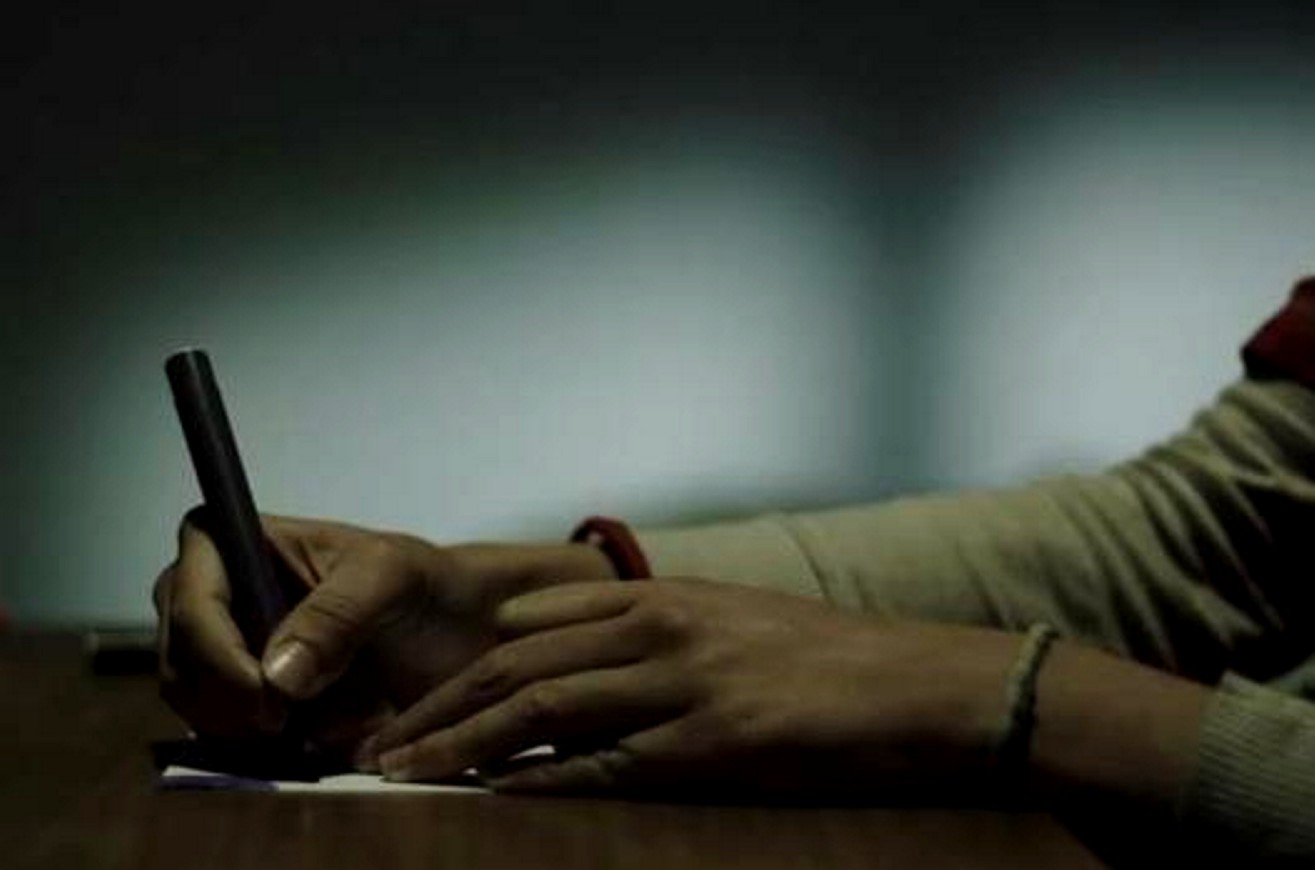
Amanda Knox rarely, if ever, mentions her “˜close friend’, murder victim Meredith Kercher. Perhaps out of her self-proclaimed desire to “˜move on with her life’.
So the recent Hands of Time (H.O.T.) music video The Mistral Blows which was posted on YouTube with a screenplay attributed to the Seattle native is nothing if not astonishing.
Whilst there is some discussion as to whether Amanda Knox wrote the entire screenplay, or a section of it, or whether the screenplay was created through a merging of several versions, the screenplay is clearly attributed to her in the credits that appear on the video.
Crediting Amanda Knox with the screenplay is repeatedly emphasized by H.O.T. themselves who posted multiple Twitter entries:
And this screenplay does Amanda Knox and her claims of innocence in the brutal murder of Meredith Kercher no favours at all.
Although provisionally “˜acquitted’ at the trial of second instance, Amanda Knox still stands accused of a capital crime, aspects of which she seems compelled to continue to portray in her various writings.
The hapless band H.O.T. might be well-advised to disassociate themselves from this endeavour and drop the video like a hot potato. The more-so as they have already burnt their fingers, tampering with the so-far elusive Brand Knox, finding themselves “˜forced to remove [clips of Knox dancing in Capanne] from the file, after a sudden, unexpected and “very strange” last-minute opposition from Amanda’s entourage.’
They state with a hint of bitterness:
The result? A compromise. The image of Knox dancing with carefree abandon in Capanne Prison (easily retrieved from other internet sites) remains, but is obliterated by a large “˜censored’ notice.
The reasons to attempt to disappear this video or, at the very least, any identifiable links with Knox, are abundantly clear to anyone having followed this dreadful case over the last four and a half years.
1) The video is riddled with allusions to the crime itself and features an easily-identifiable Amanda Knox as “˜heroine’ or “˜victim’ as she may now prefer to be seen and depending on how you look at it.
2) Any pre-book-release publicity will potentially devalue the carefully branded and preserved Amanda Knox product.
A cursory look at the video demonstrates the depraved audacity of the writer, a person who simultaneously insists she was found innocent of the crime of murder and of which she still stands accused.
The video features a Knox look-alike ““ recognizable by her clothing - in a prison-cum-house of horrors.
It opens with the heroine sitting down, colouring pictures in a prison cell. Amanda Knox was reported to spend time colouring pictures of her hands whilst in prison.
From there she leaves the cell and embarks on a journey through a range of horrifying experiences, until she finally flees the house but not the prison to which she is eternally condemned.
As she runs through the house of horrors she encounters:
1) Ghost-like figures lurching out at her hinting at the night of Halloween before the murder and the ghouls and demons of the house of horrors both in which the crime took place and in which she is forever imprisoned.
2) A tall, faceless black-haired figure dressed in black carrying an umbrella resembling Meredith Kercher dressed as a vampire on her last night alive, the red belt reminiscent of the fake costume blood and the actual blood spilled the night of the murder.
3) A faceless butcher figure dressed in a blood-stained apron holding a knife, who hands her a maggot-infested apple, reminiscent of the photograph of co-accused Raffaele Sollecito as posted on his Facebook page. The apple is suggestive of the poisoned apple offered by the witch to the innocent Snow White ““
4) Or a subliminal suggestion of Raffaele’s guilt in handing her the infested and poisonous apple “¦.. Remember: she claimed Raffaele may have pressed the murder knife with Meredith’s DNA into her hand whilst she was sleeping.
5) A figure tied to a chair covered in a red cloth hinting of the pools of blood and of Meredith unable to move to defend herself. As she reaches out to lift the red cloth the bound figure screams, sending her running out down staircases and steps and out of the house.
In the same way, witness Nora Cappezzali heard Meredith’s desperate, blood-curdling scream, followed shortly afterwards by running footsteps out of the house of horrors and onto the steel staircase near her home.
The video ends with the Knox look-alike remaining in prison. Both real and imagined.
H.O.T. suggest that the video and screenplay are a means of documenting the tale of the events in Perugia and, of course, Amanda Knox hopes to chronicle the nightmare in which she “˜innocently’ found herself. In so doing, she inadvertently describes the crime and the images, sounds and memories that will seemingly not leave her alone.
Not only are there many references to the crime, but there seems as well a clear jealous obsession with Meredith, given the numerous references and comparisons to Kristian Leontiou’s video Some Say in which Meredith hauntingly starred.
The Knox look-alike emulates Meredith from the Some Say video both in her dress and appearance as well as in her actions. She descends an old staircase, appears in doorways and through arches reminding us of the shots of Meredith and the church of the “˜Some Say’ video.
Emulation is a form of envy. Guilty or innocent, it seems Knox cannot exorcise her memories of the crime, and remains compelled to depict it in screenplays and short stories. Knox is seemingly still jealous of Meredith which had proved her original undoing. Here, in a bizarre reversal of reality, Meredith becomes the foreboding, frightening presence, whereas Knox is the shocked and terrified victim.
At a time when a tough Galati appeal to the Supreme Court and a $4 million book deal are on the table, the memory of Meredith and the crime seem to haunt and obsess Amanda Knox who may reveal a deep-seated need to confess. But while still accused, Amanda Knox cannot afford to engage in such obsessive, confessional activity.
Could this prove to be her final undoing?
Wednesday, September 28, 2011
Pseudoinnocence: Is This Possibly The Predicament Of Amanda Knox?
Posted by Vivianna
In a dissertation titled Pseudoinnocence ““ An Invitation To Murder, Barbara Shore explores the phenomenon of “pseudoinnocence” in American culture as an inadequate response to the “conflagration of violence that encircles us today.” These are her introductory words:
“America is a country long haunted by its pseudoinnocence, by its blinding prolonged naivete. We are a culture that closes our eyes to all that is too painful to see, persuading ourselves that we have escaped, that we are neither interdependent nor vulnerable, or that we are victims.
We cannot come to terms with our own unwitting complicity in the destructiveness brought to ourselves or others. Capitalizing on such naivete, we fail to see how such “˜innocence that cannot include the demonic becomes evil’ (Rollo May 50).” (Dissertation Abstracts International Section A: Humanities and Social Sciences Mar, 2001 Vol 61(9-A))
Ms. Shores’ words, although published six years before the murder of Meredith Kercher even took place, represent an eerily accurate description of Amanda Knox’s predicament, even reflecting some of the terminology employed in Attorney Carlo Pacelli’s exposition on September 26, during the closing portion of the first appeal trial. As a reminder, Pacelli, who represents Patrick Lumumba in his civil suit against Knox, pointed out that Knox “has a split personality, fresh-faced, the daughter everyone would like, Saint Maria Goretti, and then with her histrionic side [she is] an impostor, she is a she-devil, satanic, diabolic, addicted to borderline behaviour.”
Although Pacelli’s words have been seen by some as too harsh, they carry a heavy implication mirrored in the above quote from Shore ““ that “innocence that cannot include the demonic becomes evil”; in other words, that if Knox cannot reconcile her two sides and seek atonement, she has no hope of redeeming herself as a human being.
I have argued before, in a comment posted here on the TJMK board, that Knox is not likely to make a confession in the near future due to the pressures exerted by her family’s innocence campaign. The innocence campaign is, in my opinion, just one of the factors which prevent Knox from admitting her direct involvement in the crime against Meredith Kercher.
The other factors may include her failure to reconcile the two parts of her persona (innocent, carefree, kind, compassionate young woman versus “diabolical” murderer) and perhaps a culturally-engrained inability to accept involvement in a destructive act. The discussion of these latter factors is perhaps best left to someone with formal training in psychology or sociology. What I would like to enlarge upon is my conviction that there is a direct correlation between the strength of the innocence campaign and Knox’s unwillingness to admit guilt.
I would like to draw your attention to a conversation between Knox, her mother (Edda Mellas), and her father (Curt Knox) which took place in the early days of the investigation, when Amanda had already been detained. This conversation will be well-known to those who have been consistently following this case as evidence that, in the early stages, Knox may have been inclined to give a confession. I have chosen not to include it, but it is readily available on both TJMK and PMF.
The reason why I believe this conversation to be so important is not only because it might contain the beginning of the confession, but also because it highlights the involvement of her family in defining her position. I would argue that, had Knox been left to her own devices, she might have cracked in the early stages and given an accurate description of that night’s events, saving both herself, her family, the victim’s family, and anyone involved in the trial considerable grief, time, money, and effort.
At that particular point in time, she may not have been as psychologically divided and conflicted, and she may have had an easier time accepting her criminal side and perhaps moving on to experience positive changes. It is, however, her parents’ firm belief in her innocence and in her inability to commit such a heinous crime that has consistently mired her in a difficult position.
As we well know, the Knox-Mellas family hired a PR firm, Gogerty-Mariott, to clean up Amanda’s image after unflattering stories started appearing in European tabloids. The PR campaign has grown exponentially from a few stories about Amanda’s childhood, complete with baby pictures, to what I consider to be a falsification of public opinion.
On the one hand, there is a concerted effort to offer inaccurate information about existing evidence (limiting the crime scene to Meredith’s room, stating that there is no evidence linking Amanda and Raffaele to the murder, pushing Rudy Guede as the “lone wolf” assassin, etc.), which is then fed to news outlets unwilling to do their own research and pushed upon the unsuspecting public via books, blogs, and forums. Then comes the even more insidious effort to falsify the public’s response to these stories, by hiring posters to write positive reviews for FOA books, post positive comments to inaccurate stories, and shout down any reasonable opposition.
Of course, this entire effort does not come cheaply, and rumors say that the PR campaign’s tab is around one million. This is an enormous debt to place on the shoulders of a young woman who already needs to contend with the guilt of having committed an incomprehensible, heinous, violent crime. While it is difficult to feel sympathy for any of Meredith’s killers, I find it impossible not to feel a certain amount of compassion for Amanda, who most likely never asked for this campaign to be initiated. How could she admit her role in this crime when a million dollars has already been spent to trumpet her innocence?
In addition to the material aspects, there are social and psychological aspects to contend with. While many of the FOA members are paid for their public appearances and statements (and may not harbor any personal opinions about the case), there seem to be individuals who are supporting Amanda’s innocence out of personal conviction. Some of them may have even donated money to help her family. How could she disappoint everyone who invested money and time into supporting her, from her own family to charitable strangers? How could she look them in the eye, after four years of lies and obfuscation, and admit that she was terrified of being punished, or incapable of seeing herself as a murderer?
Peter Quennell has suggested to me that this may be an example of “path dependence,” a concept used in both economics and social sciences to describe a scenario in which current actions and decisions are inexorably determined by past decisions. While my personal knowledge of path dependence is limited, I think that it is certainly applicable in this case and that it can be traced back to the prison conversation discussed before. During the conversation, Amanda’s parents indirectly communicated to her that the course had been set ““ that the legal team would handle all questions and that she was not to communicate her thoughts without supervision; also that a confession would be unacceptable because she was undeniably innocent.
As to why her family took this position, I think we can find the answer in the concept of pseudoinnocence ““ the inability to accept responsibility for and involvement in a terrible event, accompanied by a forced distancing from anything that could be considered troubling.
It is not a coincidence that Amanda has been consistently portrayed as a victim of the supposedly corrupt, medieval Italian justice system, as someone who has been “railroaded” in a “third-world” country, as her supporters want us to believe. It is more comforting to become a victim than to accept responsibility and acknowledge that Amanda’s problems may have started at home, long before she was on a plane for Perugia. I believe that the innocence campaign is not only meant to exculpate Amanda, but to also exculpate her family from any perceived contributions to the formation of a murderer.
As long as Amanda’s family continues to invest so much money and effort into supporting her innocence, and to maintain so much publicity around her case, I believe that any professional attempts to help Amanda admit her involvement will prove ineffective. This entire undertaking, combined with her own psychological dividedness and any cultural influences, is placing an enormous amount of unnecessary responsibility on Amanda and displacing a more appropriate type of responsibility.
Amanda, at this point, should feel responsibility towards Meredith and Meredith’s family primarily. While the murder itself cannot be reversed and no true solace offered, a confession would offer a certain amount of closure to those who knew and loved Meredith. Instead, Amanda’s sense of responsibility is being artificially redirected to not disappointing her own family and supporters, and to not betraying the trust they have placed in her innocence. Aside from being hurtful to the victim’s family, this situation is also damaging for Amanda herself, as it’s setting her on a path of continued “evil” rather than one of heal


